

When record numbers of Americans tuned into watch the final episode of “MASH” in 1983, the cozy, communal ritual of family viewing was already in the throes of a revolution. The old world of three major networks and high-minded scripted dramas was in its final days, as the spread of cable television fractured the viewing audience into thousands of constituencies, each with its own set of preferences and, thanks to the remote control, the power to dictate terms.

The original ‘Walkman,’ model TCS 300, made by Sony of Japan in 1980.
In all the arts, choice proliferated and habits of consumption changed. Sometimes new technology altered the landscape. The Sony Walkman allowed music fans to listen on the move. The compact disc, which instantly made the vinyl LP obsolete, improved sound quality and made storage easier. With the camcorder, introduced by Sony in 1982, anyone could make a video.
Television viewers faced a new world of seemingly infinite variety. The same small screen accommodated “Masterpiece Theater” and programs like “Married … With Children,” a raunchy new comedy on the fledgling Fox Network that pushed the boundaries of good taste.

MTV VJ Downtown Julie Brown on the set in MTV’s New York Studio in 1988.
MTV, a startup channel that broadcast music videos round the clock, turned out to be something more than a modern version of “American Bandstand.” It was a showcase for the latest street fashions, a training ground for aspiring directors, and a cinematographic innovator. Its hectic visual style, with constant quick cuts, had an immediate impact on longer-form television shows and film.
Culture became a battleground, reflecting the same divisions that would split the country evenly between red and blue states. Rock music loomed a moral threat in a way it had not since the days of Elvis Presley. Alarmed at the salaciousness and profanity she heard in rock songs, Tipper Gore joined forces with several other prominent political wives to form the Parents Music Resource Center. The organization lobbied the music industry to attach warning labels to records with sexually explicit or profane lyrics. The issue became more heated with the growing popularity of rap music, especially gangsta rap and groups like Public Enemy.
Projection of a Robert Mapplethorpe self-portrait during a protest at the Corcoran Gallery of Art in 1989.
The motion picture industry faced similar concerns. In 1984 it introduced a new rating, PG, to alert parents that a film contained language or images that might not be suitable for younger viewers.
The visual arts, not normally a hotbed of social controversy, inflamed passions, especially on Capitol Hill, when a new breed of political artists began showing at publicly supported museums. Robert Mapplethorpe’s elegant, shockingly sexual photographs of gay men caused a furor when they were included in an exhibition at the Corcoran Gallery of Art in Washington that was funded, in part, by the National Endowment for the Arts. Andres Serrano’s photograph “Piss Christ,” which shows a crucifix immersed in a glass vessel filled with urine, set off a storm of controversy and set the stage for the “culture war” between the art world, the endowment, and conservative lawmakers in Washington.
Strife and contention, although fierce, was intermittent. For most audiences the arts delivered pleasure, pure and simple. Hollywood film in particular fell into an easy rhythm of action movies, horror films and many, many sequels.
The 70’s had been a golden age of sorts, with challenging films both domestic and foreign. Martin Scorsese continued to flourish in the 1980’s, making what many critics called his finest film, “Raging Bull,” but the big box-office hits tended to be franchise films like “Beverly Hills Cop,” “Lethal Weapon,” “Airplane” and “Halloween,” which generated sequel after sequel. The “Star Wars” juggernaut continued to roll in “The Empire Strikes Back” and “Return of the Jedi,” both phenomenally successful, but still not as big as Steven Spielberg’s “E.T. the Extra-Terrestrial.”
The target audience was, increasingly, young. John Hughes’s gentle comedies about teen life, like “The Breakfast Club” and “Pretty in Pink,” made instant stars out of Molly Ringwald and the young actors dubbed the “Brat Pack.” The growing sophistication of computer-generated special effects narrowed the differences between film and video games. “Tron,” a 1982 science-fiction film inspired by video games, marked a cinematic turning point. Actors faced a new dawn in which they ran a distant second to digitally produced images and explosions.
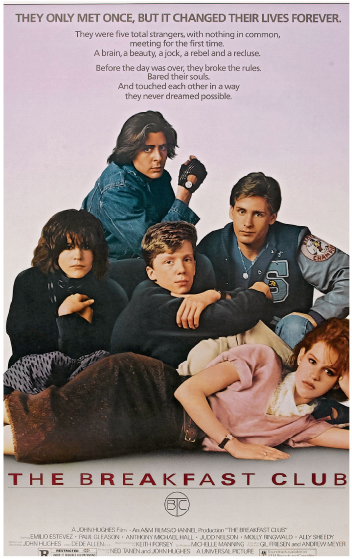
The big-budget blockbusters still left room for quirky independent films, which gained box-office credibility after the low-budget “Sex, Lies, and Videotape” took in millions at the box office. Directors like Jonathan Demme, in films like “Melvin and Howard” and “Something Wild,” and David Lynch, in “Blue Velvet,” showed that the renegade spirit of the previous decade had not died.
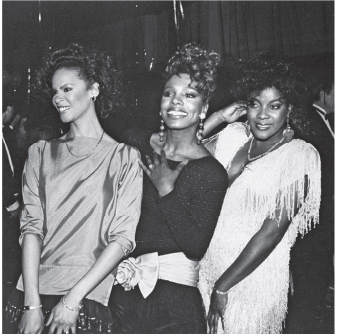
Actresses, Debra Burrell, Sheryl Lee Ralph & Loretta Devine from the cast of Dreamgirls.
In pop music, Michael Jackson emerged as a megastar. “Thriller,” released in 1982, became the best-selling album of all time. Madonna began her climb to international celebrity. In a memorable demonstration of celebrity power, the biggest names in rock ’n’ roll staged an epic benefit concert, Live Aid, to raise money to alleviate the famine in Ethiopia.
Jazz showed surprising resiliency. Miles Davis staged a comeback early in the decade, and a group of young traditionalists, led by a trumpet player from New Orleans, Wynton Marsalis, revived interest in the traditional jazz music of the 1930’s. Lincoln Center staged a series of concerts that led to the creation of a permanent jazz program.
A British invasion swept over Broadway. One after another, lavish musicals like “Cats,” “Les Miserables” and “Phantom of the Opera” opened to rapturous applause and never left, running year after year. The homegrown Broadway musical, one of America’s great gifts to the world, seemed exhausted, although national honor was saved with the triumphant opening of “Dreamgirls.” The show, loosely based on the story of the Supremes, proved that Andrew Lloyd Webber did not have an absolute monopoly on the genre.
The Thatcher era, with its new mercantile spirit, provoked a response in politically minded playwrights like David Hare and Caryl Churchill, whose piercing looks at contemporary Britain impressed critics on both sides of the Atlantic. In the United States, Larry Kramer put the tragedy of AIDS on the stage with his groundbreaking play “The Normal Heart.”
The dance world lost two giant figures, George Balanchine and Alvin Ailey. Suzanne Farrell, one of the century’s greatest dancers, retired. But there was also an influx of fresh talent. Mark Morris assembled a company of dancers that brought a new sense of wit and invention to the stage, and Twyla Tharp entered into a brilliant creative partnership with Mikhail Baryshnikov, who took over as artistic director of the American Ballet Theatre at the beginning of the decade. Darci Kistler, a protégé of Balanchine, became a principal dancer at the New York City Ballet, the youngest in its history at only 17.
Cable television diminished the power of the networks, and the advent of CNN, not to mention the retirement of Walter Cronkite as anchor of “The CBS Evening News,” foretold the end of network dominance in the news. But the networks could still produce enormously popular comedies and dramas. Prime-time soaps like “Dallas” and “Dynasty” kept Americans glued to the set, and innovative series like “Cheers” and “Hill Street Blues” stretched the boundaries of their genres. “The Cosby Show” in particular was a landmark, a comedy series that presented black Americans in the round, endowed with the full range of human complexities, problems and emotions.
The visual arts took center stage, and not just because of the culture wars. A brash new style of painting, Neo-Expressionism, brought a new generation of artists to public attention. A flood of Wall Street money fueled sky-high prices for all forms of art, but artists like Julian Schnabel and Jeff Koons showed a distinct flair for marketing and media manipulation, proof that the lesson of Andy Warhol had been closely studied. Artists and their dealers no longer labored quietly; artists wanted to be famous, and their handlers took pains to make that happen. Never had the machinery of art, fashion, money and celebrity meshed so tightly.
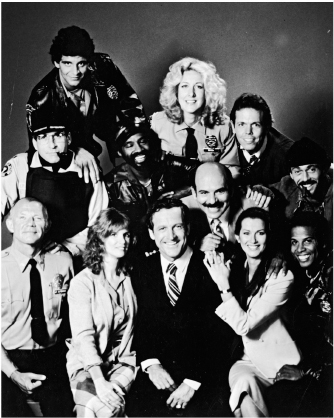
The 1981 cast of “Hill Street Blues.”
The Nobel Prize in Literature, often awarded to esoteric writers in past decades, redeemed itself in the 1980’s, honoring the likes of Joseph Brodsky, Czeslaw Milosz, Gabriel Garcia Marquez and Wole Soyinka. At the same time, younger writers staked their claim. In the United States, a literary brat pack—Jay McInerney, Tama Janowitz and Bret Easton Ellis—looked like the 1980’s answer to the Beats of the 1950’s.
Commentators worried about declining literacy and the degeneration of the English language. The spread of Valley Girl dialect did not help. Allan Bloom, a classics professor at the University of Chicago, made the best-seller list with “The Closing of the American Mind,” a prolonged lament about the failure of higher education and the sorry state of American culture. E.D. Hirsch, another academic, put the case starkly in his best-selling “Cultural Literacy,” arguing that Americans simply did not know the facts that an educated person should know.
Both books set off a fierce debate. Were Americans under-educated, ill-informed, uncouth? If so, why did the 1980’s offer such rich pickings in art, music, theater, literature and dance? The decade was turbulent and confusing. The cultural friction was undeniable, so were the achievements.
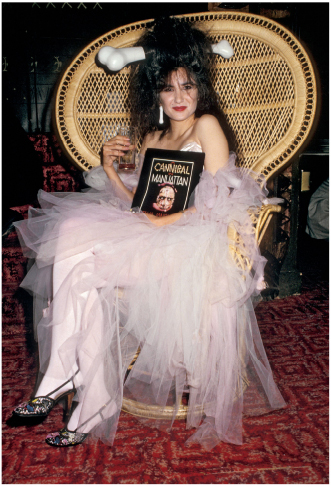
Tama Janowitz at her book party for “A Cannibal In Manhattan” in 1987.
MAY 18, 1980
A Show That Might Even Have Dazzled Picasso; Picasso at the Modern

MOMA painting and sculpture director William S. Rubin in front of Pablo Picasso’s “Les Demoiselles d’Avignon” in 1984.
“I want people to go out of here reeling, to have a sense of ‘How could he do it?” says William Rubin, who assembled the cornucopian Picasso show—one of the largest and most important art displays of our time that will cram the Museum of Modern Art’s entire building from May 22 through Sept. 16.
The exhibition, a near-$2-million extravaganza formally entitled “Picasso: A Retrospective” presenting almost 1,000 works in every medium by the protean Spanish artist, who is generally acknowledged as the dominant figure of 20th century art, will undoubtedly be Mr. Rubin’s curatorial chef d’oeuvre. About 300 of the works have never been seen before in this country, and 30 works have never been seen anywhere, including a 1956 wood version of a sculpture group called “The Bathers,” lent by one of Picasso’s heirs.
On the eve of the 100th anniversary of his birth in 1881, Picasso is seen, in the main body of critical opinion, as the towering progenitor of the art of our time, a position achieved not only by the immense fertility of his invention that led to the revolutionary style of Cubism, but also the sheer prodigality of his output. In the artist’s estate at his death, for example, were 1,855 paintings, 1,228 sculptures, 7,089 drawings, 3,222 ceramic works, 17,411 prints, and 11 tapestries. “No artist invented so much in one lifetime,” says Mr. Rubin. “There’s enough material in the MOMA show to make 50 other careers.”
The show was proposed by Mr. Rubin on a visit to Picasso shortly before the artist’s death in 1973. Picasso was “amused” by the notion of a museum-wide show, according to Mr. Rubin, and agreed to collaborate. But the artist’s death a few months later brought preparations to a halt. Only after the recent resolution of his tangled estate could the project again be seen as a possibility.
The show is certainly the most comprehensive Picasso exhibition ever mounted. “But the unbelievable thing is that you could fill the museum again with terrific Picassos that are not in the show,” notes Mr. Rubin. 
SEPTEMBER 28, 1980
BUILDING ON EMOTIONS
There are many terms for it—romanticism, neo-eclecticism, a return to ornament, postmodernism. They do not mean the same thing, but they are all attempts to explain, in one way or another, a certain feeling that has been in the air for some time now. Architects and decorators talk willingly today of pleasure, of delight, of prettiness even. They seem to talk less of rules and more of whims, less of order and more of randomness, less of physical structure and more of spirit and mood. Even the most rigorous modernist seems compelled to say a word or two about emotional content when defending his or her work, and he or she who speaks only in terms of purity of space and structure, the words of modernism’s gospel, is likely to sound rather old-fashioned.
It is tempting, when one ponders the situation, to say that the world of architecture and design has been turned upside down. After all, two years ago Philip Johnson, once modernism’s leader, and John Burgee designed a limestone-fronted structure, complete with classical moldings, for the apartment house at 1001 Fifth Avenue in New York City. When one looks at this curious building and then looks back at, say, Ludwig Mies van der Rohe’s great 860-880 Lake Shore Drive apartments in Chicago of 1950, it is a startling comparison: The new building is what looks old-fashioned, while the “modern” building, the box of steel and glass, turns out to be 30 years old.
No more. Now, not only is Philip Johnson going about creating classical ornament, but we also have architects like Allan Greenberg, who is designing a “real” Georgian manse; Charles Moore, who has been mixing elements from various cultures and periods for some time and now does so with more exuberance than ever; Robert Stern, whose mix of classical allusions and elements from the Shingle Style is increasingly articulate; Michael Graves, whose rich colors and subtle forms, derived from classicism but highly personal, are nothing if not romantic. There are many other, younger architects working in similar directions.
This sort of romanticism is what we might call the romanticism of aspiration—it uses historical details and historical style in the hope of conveying certain qualities of a past period. It is a kind of design with a social goal as much as a purely visual one, and it often has a pleasing kind of innocence to it.
All of this is, at bottom, a reaction against modernism. Its austerity, we have finally realized, served too narrow a range of the human psyche; without a certain kind of attention to the broader range of human emotions, service to the eye has insufficient meaning.
This does not mean that modern design is finished, that we will see no more of it—far from it. But what we will see are more and more variations on modernist themes, such as a designer like Saladino offers or, as, say, Kevin Roche created in his sparkling, decorative, yet utterly modernist United Nations Plaza Hotel, an attempt to bring a level of emotional content to the modern design vocabulary. 
JULY 12, 1981
EXPRESSIONISM RETURNS TO PAINTING
In art, every authentic style comprehends a distinctive point of view. It exalts certain emotions, and upholds certain attitudes. It makes a judgment about the medium, and a judgment about life. Upon its emergence it proffers a revision of existing ideas about art, and thus—either by implication or by direct assault—represents a challenge to the prevailing orthodoxies. Every genuine change of style may therefore be seen as a barometer of changes greater than itself. It signals a shift in the life of the culture—in the whole complex of ideas, emotions and dispositions that at any given moment governs our outlook on art and experience.
In the visual arts, a change of this sort is now apparently upon us in the form of an energetic wave of Neo-Expressionist painting. This burgeoning movement has swiftly achieved a remarkable success on both sides of the Atlantic—for it is as much a European as it is an American movement—and it is now the focus of a good deal of critical discussion and acclaim.
In this country, for example, the outstanding figures at the moment are Julian Schnabel, Susan Rothenberg and the British-born painter Malcolm Morley—three very individual artists whose work does not seem to have much in common until placed in the perspective of the conventions they have vigorously repudiated.
In Italy, where the movement has erupted with particular force, its leaders appear to be Francesco Clemente, Sandro Chia and Enzo Cucchi—though they are themselves part of a larger group whose work has already been shown at museums in Basel, Essen and Amsterdam. In Germany, not surprisingly, the Neo-Expressionists have won a great deal of attention, for it was in Germany that the Expressionist movement originated some 75 years ago, and its revival is therefore seen as, among other things, a vindication of a national artistic tradition.
But what, as they say, is it all about?
One thing it is about, surely, is the legitimization of a mode of painting that exults in the physical properties of the medium, and in its capacity to generate images and stir the emotions. This is painting that makes a very frank appeal to the senses at the same time that it addresses itself without embarrassment to our appetite for poetry, fantasy and mystery. It swamps the eye with surfaces that are shameless in their exploitation of tactile effects, and with vivid images that are not always susceptible to easy explanation or understanding. It is painting that relies more on instinct and imagination than on careful design and the powers of ratiocination. It shuns the immaculate and the austere in favor of energy, physicality and surfeit.
Against the “closed” styles so long in fashion, the Neo-Expressionists offer us painting that is nothing if not “open”—painting that releases the medium from the restraints of high-minded theory in order to allow fantasy and emotion to play a more forthright role in determining the boundaries of pictorial discourse. 
MAY 15, 1983
ARTISTS GRAPPLE WITH NEW REALITIES
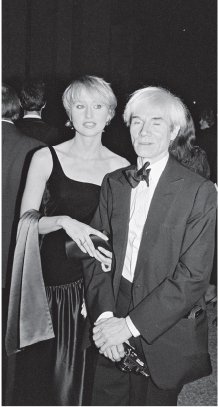
Cindy Sherman with Andy Warhol in 1982.
There is no question in most artists’ minds that the art world has changed dramatically in the last few years. It is bigger, faster and more conspicuous than before. There are more artists, dealers, collectors, agents, promoters and people writing about art. There is more to be won and lost now, at an earlier age.
In short, the art world has become big-time. With the emergence of a $2 billion a year art market in New York alone and the institutionalization of the avant-garde, not only by museums, where work is often on the walls while the radical edge is still hot, but also by universities, where more and more avant-garde artists have been hired to teach more and more studio art programs, art has entered the mainstream of American life.
What these changes mean for art, however, how they affect the making of art and the artists, is a matter of ongoing discussion and sometimes urgent concern. As art has entered the mainstream of American life, the mainstream of American life, with its turbulent as well as its bracing currents, has edged deeper and deeper into the world of art. On the one hand, the art world has probably never generated so much excitement and interest and touched off so many dreams. The audience for art continues to increase. With the success of such artists as David Salle, Julian Schnabel, Robert Longo and Cindy Sherman, all around 30 years old, and Keith Haring and Jean Michel Basquiat, still in their early twenties, artists now begin their careers knowing they have a chance for fame and fortune at an age that was almost unthinkable even ten years ago.
On the other hand, there is a widespread belief that worldliness, big money, instant stardom and art are incompatible—and that if they do co-exist, the integrity and scope of the art must suffer. There is no doubt that as the stakes increase, the pressures, distractions and temptations with which artists in New York now live have become more and more intimidating. Furthermore, as the media wait impatiently for the next “hot” artist and more and more collectors’ limousines roll into SoHo to line up for work that has not yet been created, there is also an increasing danger of artists becoming themselves commodities. “There’s this using up,” said the 31-year old sculptor Timothy Woodman. “You’re discovered, you’re used up, you’re out.”
The questions being raised about the art world now could not be more consequential. Is it still possible, given the conditions which have generated so much interest and made so much possible, to create work with the integrity and purpose that have always given art its necessity? With the pressure to “make it,” the possibility of something like immediate gratification, and the distorting amount of attention successful artists may receive, can artists continue to reach for something beyond vanity and the moment?
For some artists, whatever the situation, the issue has been and always will be the strength and will of the individual. “I really believe the pressure comes from me and not the art world,” Mr. Salle said. “I don’t think anything today has changed the difficulty of making significant art and the steep odds against it.” 
JANUARY 8, 1984
PHILIP JOHNSON DESIGNS FOR A PLURALISTIC AGE
Several years ago, as it started to rain at an architects’ picnic in Princeton, one of those present suggested that the group call Philip Johnson and “ask him to have it stop raining.”
No one made the call, but the anecdote is telling. “He is the most powerful architect since Bernini,” says the New York architect Peter Eisenman. To many observers, Mr. Johnson is a figure of enormous power—an architect whose reputation is an issue almost independent of his buildings, and possibly one of his most impressive constructions.
But the appreciation is not entirely unmixed. The outspoken James Marston Fitch, professor emeritus at the Columbia University School of Architecture, says “he is impregnable,” even though “fundamentally frivolous.”
Mr. Johnson is perhaps now somewhere between being more controversial than ever and beyond controversy: the architect is attracting the most substantial commissions of his career—such as the proposal for four new towers he recently presented for the revitalization of Times Square. He is responding with designs, pleasing for some people, merely glib to others, but that are certainly expanding the traditionally conservative corporate palette.
One of the few elements that ties Mr. Johnson’s widely divergent buildings together is, in fact, their pinstriped urbanity—their elegant finish helps mask the architectural shock that few other architects would be able to get away with. Besides the Chippendale top of the A. T.& T. Building, he has designed a Gothic skyscraper for Pittsburg Plate Glass, a Dutch-gabled high-rise in Texas, and is now working on a high-rise Welsh castle apartment building with a crenellated top for Donald Trump. Other than their sophisticated level of finish and detailing, a certain light Cole Porter wit, and their efficient interior planning, there are remarkably few characteristics common to these buildings—and none that might add up to a consistent system of belief.
As an architect who “cannot not know history,” Mr. Johnson has thoughts about his place in it, and as usual he is of several minds. On the one hand, he says, “we think we’re creating architectural history.” But on the other hand, “I don’t see myself as important, but I might eventually be considered important. With these startling commissions in different cities—like the Pennzoil—I’m getting a different level of acceptance than I used to.”

The A. T. & T. Building in New York City, designed by Philip Johnson and John Burgee.
MARCH 7, 1986
GEORGIA O’ KEEFFE DEAD AT 98;
SHAPER OF MODERN ART IN U.S.
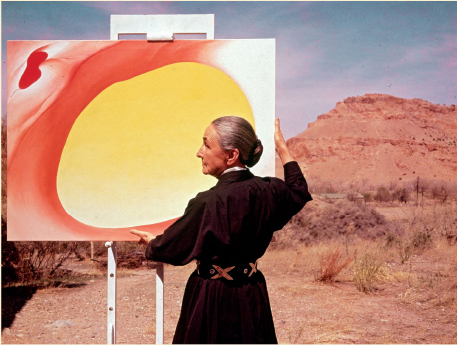
Georgia O’Keeffe adjusting a canvas from her “Pelvis Series-Red With Yellow,” in Albuquerque, New Mexico, 1960.
Georgia O’Keeffe, the undisputed doyenne of American painting and a leader, with her husband, Alfred Stieglitz, of a crucial phase in the development and dissemination of American modernism, died yesterday at St. Vincent Hospital in Santa Fe, N.M. She was 98 years old, and had lived in Santa Fe since 1984, when she moved from her longtime home and studio in Abiquiu, N.M.
As an artist, as a reclusive but overwhelming personality and as a woman in what was for a long time a man’s world, Georgia O’Keeffe was a key figure in the American 20th century. As much as anyone since Mary Cassatt, she raised the awareness of the American public to the fact that a woman could be the equal of any man in her chosen field.
Miss O’Keeffe burst upon the art world in 1916, under auspices most likely to attract attention at the time: in a one-woman show of her paintings at the famous “291” gallery of Alfred Stieglitz, the world-renowned pioneer in photography and sponsor of newly emerging modern art.
From then on, Miss O’Keeffe was in the spotlight, shifting from one audacious way of presenting a subject to another, and usually succeeding with each new experiment. Her colors dazzled, her erotic implications provoked and stimulated, her subjects astonished and amused.
The artist painted as she pleased, and sold virtually as often as she liked, for very good prices. She joined the elite, avant-garde, inner circle of modern American artists around Stieglitz, whom she married in 1924.
Long after Stieglitz had died, in 1946, after Miss O’Keeffe forsook New York for the mountains and deserts of New Mexico, she was discovered all over again and proclaimed a pioneering artist of great individuality, power and historic significance.
Miss O’Keeffe had never stopped painting, never stopped winning critical acclaim, never stopped being written about as an interesting “character.” But her paintings were so diverse, so uniquely her own and so unrelated to trends or schools that they had not attracted much close attention from New York critics.
Then, in 1970, when she was 83 years old, a retrospective exhibition of her work was held at the Whitney Museum of American Art. The New York critics and collectors and a new generation of students, artists and aficionados made an astonishing discovery. The artist who had been joyously painting as she pleased had been a step ahead of everyone, all the time.
THE LOWER EAST SIDE’S NEW ARTISTS
In the early 1980’s, Meyer Vaisman and Peter Nagy were young artists in Manhattan, both in their early 20’s and both recently graduated from art school. And both, when unable to find an existing commercial gallery in New York to show their work, took an increasingly common step for young artists in Manhattan: they started their own galleries.
Today, Mr. Vaisman’s gallery, International With Monument, and Mr. Nagy’s, Nature Morte, are two of the most successful on the Lower East Side, a thriving new commercial art district in New York. And the two young men have become quite successful as artists, as well.
Their story typifies a change that has taken place in New York’s contemporary art scene, which in recent years has been transformed from a relatively small and cloistered world to a thriving industry that makes stars of unknowns and has spawned growing numbers of galleries, trade publications and entrepreneurs.
There were around 200 art galleries in the New York metropolitan area in 1976, mostly in the traditional art districts of 57th Street and SoHo, according to the Gallery Guide, which lists New York art galleries. Today, the guide lists 560 galleries in the New York area, including such Manhattan neighborhoods as the Upper East Side, NoHo, Tribeca and the Lower East Side. The Art Dealers Association of America estimates that there are $1 billion a year in fine-art transactions in New York City.
The breeding ground for many of the new artists has been the Lower East Side, which, in the last five years, has been the fastest growing of all the art districts of New York. Although there were virtually no art galleries there in 1980, there are nearly 100 there today. In tiny storefronts previously occupied by Ukrainian- and Polish-American shops, dozens of new art galleries have been started each year by young entrepreneurs, many of them young artists.
Some days, the Lower East Side, which is called the East Village by many, looks like a cultural version of the garment district, with artists and art handlers carrying canvases still wet with paint from their apartment studios to nearby galleries to display. The local cafes, which have proliferated along with the galleries, are filled with artists and dealers, and gallery owners frequently take groups of collectors to artists’ studios to try to interest them in works that are still in progress.
It is in this environment that many young artists have recently made their start in the art world—and done so with a splash. 
FEBRUARY 10, 1985
NEW ART, NEW MONEY
When Jean Michel Basquiat walks into Mr. Chow’s on East 57th Street in Manhattan, the waiters all greet him as a favorite regular. Before he became a big success, the owners, Michael and Tina Chow, bought his artwork and later commissioned him to paint their portraits. He goes to the restaurant a lot. One night, for example, he was having a quiet dinner near the bar with a small group of people. While Andy Warhol chatted with Nick Rhodes, the British rock star from Duran Duran, on one side of the table, Basquiat sat across from them, talking to the artist Keith Haring. Haring’s images of a crawling baby or a barking dog have become ubiquitous icons of graffiti art, a style that first grew out of the scribblings (most citizens call them defacement) on New York’s subway cars and walls. Over Mr. Chow’s plates of steaming black mushrooms and abalone, Basquiat drank a kir royale and swapped stories with Haring about their early days on the New York art scene. For both artists, the early days were a scant half dozen years ago.
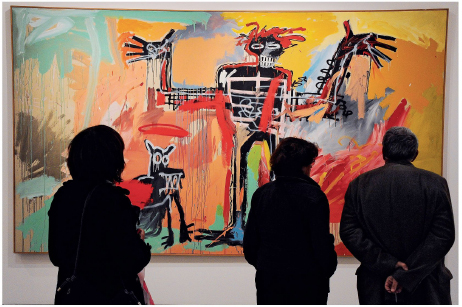
Visitors stand among paintings by artist Jean Michel Basquiat which are part of an exhibition of 150 works of art by Basquiat, at Musee d’Art Moderne on October 15, 2010 in Paris, France.
That was when the contemporary art world began to heat up after a lull of nearly a decade, when a new market for painting began to make itself felt, when dealers refined their marketing strategies to take advantage of the audience’s interest and when much of the art itself began to reveal a change from the cool and cerebral to the volatile and passionate.
But today, contemporary art is evolving under the avid scrutiny of the public and an ever-increasing pool of collectors in the United States, Europe and Japan; and it is heavily publicized in the mass media. Barely disturbed by occasional dips in the economy, the art market has been booming steadily.
Take Basquiat. Five years ago, he didn’t have a place to live. He slept on the couch of one friend after another. He lacked money to buy art supplies. Now, at 24, he is making paintings that sell for $10,000 to $25,000. They are reproduced in art magazines and also as part of fashion layouts, or in photographs of chic private homes in House & Garden. They are in the collections of the publisher S. I. Newhouse, Richard Gere, Paul Simon and the Whitney Museum of American Art.
His color-drenched canvases are peopled with primitive figures wearing menacing masklike faces, painted against fields jammed with arrows, grids, crowns, skyscrapers, rockets and words. “There are about 30 words around you all the time, like ‘thread’ or ‘exit,’” he explains. He uses words “like brushstrokes,” he says. The pictures have earned him serious critical affirmation. In reviewing a group show of drawings last year, John Russell, chief art critic of The New York Times, noted that “Basquiat proceeds by disjunction—that is, by making marks that seem quite unrelated, but that turn out to get on very well together.’ His drawings and paintings are edgy and raw, yet they resonate with the knowledge of such modern masters as Dubuffet, Cy Twombly or even Jasper Johns. What is “remarkable,” wrote Vivien Raynor in The Times, “is the educated quality of Basquiat’s line and the stateliness of his compositions, both of which bespeak a formal training that, in fact, he never had.’
In the last year or so, Basquiat has established a friendship with an artist who probably understands the power of celebrity better than anyone else in the culture. Once when he was trying to sell his photocopied postcards on a SoHo streetcorner, he followed Andy Warhol and Henry Geldzahler into a restaurant. Warhol bought one of the cards for $1. Later, when Basquiat had graduated to painting sweatshirts, he went to Warhol’s Factory one day. “I just wanted to meet him, he was an art hero of mine,” he recalls. Warhol looked at his sweatshirts and gave him some money to buy more.
Their friendship seems symbiotic. As the elder statesman of the avant-garde, Warhol stamps the newcomer Basquiat with approval and has probably been able to give him excellent business advice. In social circles and through his magazine, Interview, he has given Basquiat a good deal of exposure. Though Warhol teases Basquiat about his girlfriends, Basquiat finds the time to go with Warhol to parties and openings. In return, Basquiat is Warhol’s link to the current scene in contemporary art, and he finds Basquiat’s youth invigorating. “Jean Michel has so much energy,” he says. One acquaintance suggests that the paternal concern Warhol shows for Basquiat—for example, he urges the younger artist to pursue healthful habits and exercise—is a way for Warhol to redeem something in himself. When asked how Warhol has influenced him, Basquiat says, “I wear clean pants all the time now.” 
FEBRUARY 10, 1985
IN LONDON, A FINE HOME FOR A MAJOR COLLECTION
One of the more unpredictable places in which recent art of high quality can henceforth be seen in ideal conditions is on Boundary Road in Northwest London. As its name suggests, Boundary Road is somewhat on the edge of things. Lightly trafficked, it has a metropolitan bit, a suburban bit and a villagey bit. The villagey bit includes a betting shop, a take-out Tandoori shop, and in fact a whole clutch of the diminutive, highly characterized one-family stores that George Orwell described so well in the 1930’s. It also has, or had, a little factory tucked away at the back not far from the junction of Boundary Road and Abbey Road.
That factory was a rundown sort of place when it was bought a year or two ago by Charles Saatchi, who is best known as the co-founder in first youth of Saatchi & Saatchi, an advertising agency that does a multimillion-dollar business in many parts of the world. Charles Saatchi is also well known—some would say notorious—in the international contemporary art establishment for the collection of recent art that he and his wife have been forming since the late 1960’s.
The private collector of new art, as he existed in pre-revolutionary Moscow, in Switzerland in the first half of this century and in the United States today, has had few parallels in England. It was, therefore, thought in London to be in rather bad form—pushy, if not actually disreputable—when the Saatchis not only bought the paintings and sculptures that they most liked, but bought them in large numbers. No one knew exactly what they had, but in major international loan exhibitions they made their mark as lenders over and over again.
It did not endear them to English artists, who have a hard time scratching a living from local collectors, that they spent a lot of time in the United States and bought heavily in the domain of American art. Nor did it endear them to American artists that more recently they have bought heavily in the domain of German and Italian art.
This situation was further complicated by the fact that although in his professional activity Charles Saatchi is a laconic lord of language who can make one word do the work of 50, he has never in his life given an interview, whether about the collection or about anything else. Nor is he going to start doing so now. It is also pertinent that the four-volume catalogue is entitled “Art of Our Time” in very large letters, and subtitled “The Saatchi Collection” in very small ones. It includes appreciations of the artists by many good writers—among them Hilton Kramer, Peter Schjeldahl, Robert Rosenblum, Rudi Fuchs and Jean-Christophe Ammann—but the Saatchis themselves are never mentioned.
Given that the collection as catalogued includes nearly 500 works by 45 artists—of which perhaps one-tenth at most can be shown at any one time—the inaugural show could have been a promiscuous catchall. But the Saatchis have opted for plain grand statement, and for the presentation in depth of four artists—Donald Judd, Andy Warhol, Cy Twombly and Brice Marden. The result suggests that a golden age in art can take many forms, and that one of them can be found in the achievement of the 1960’s and 70’s.
Doubtless these matters will be debated as long as the Saatchis are an active force in the art market. Meanwhile, two things need to be said. One is that Max Gordon has contrived for them one of the most blissful spaces of its kind that this visitor has ever trodden. The other is that on the evidence of the catalogue there is material in the collection for a series of densely thought-through and sometimes definitive exhibitions that could continue for five or six years at least.
The unnamed gallery at 98a Boundary Road, London N.W.8. is at present open by appointment only. Anyone who is interested to go can telephone London O1-624-8299 as of now. 
NOVEMBER 17, 1985
YOUTH—ART—HYPE:
A DIFFERENT BOHEMIA
Ann Magnuson sits on a worn couch in her East Village apartment, rummaging in the junkyard of American culture. She talks, with affectionate mockery, about icons and totems and slogans, past and present. Her allusions spill out like the contents of some crazed time capsule—Steve and Eydie, “The Beverly Hillbillies,” Patty Hearst, Gidget, Wonder bread, Amway, TV evangelists, Lawrence Welk, Jim Morrison and the Doors, Chicken McNuggets, high-fiber diets, midstate pork princesses, Mantovani, Mr. Spock and “Beyond the Valley of the Dolls.”
Recently christened “the Funny Girl of the avant-garde” by People magazine, the 28-year-old conjures up these spirits in her satirical skits for downtown clubs such as Area, Danceteria and the Pyramid. Her characters include Mrs. Rambo, who shoots her way through Bloomingdale’s to save Nancy Reagan from getting a New Wave makeup job at the Yves St. Laurent counter, and Fallopia, Prince’s new protégé, who is really Delores Jean Humpshnoodleburger, a graduate of the Rose-Marie School of Baton and Tap in Duluth.
She is a performance artist with a cult following and the area where she lives and works is simply called downtown.
She is at the center of the vivid New York arts community that has captured international attention spinning what has come to be known as “the downtown style.” The artists cannibalize high art and the mass culture of the last three decades—television, suburbia, pornography, Saturday morning cartoons, comic books, Hollywood gossip magazines, spirituality, science fiction, horror movies, grocery lists and top-40 lists.
“It’s everything turned inside of itself, it’s sensory overload,” Ann Magnuson says. “It’s a postmodern conglomeration of all styles. You steal everything.”
Although there are one or two outposts above 14th Street, the community begins there and moves fitfully down Manhattan, through the East Village, the Lower East Side and, on the West Side, down through TriBeCa to the Battery. It tends to hug the edges of the island and carefully avoids that older artists’ haunt, Greenwich Village.
Just as irony is the hallmark of the downtown style, the word bohemia takes on an ironic twist when used to describe this arts community. For this is a bohemia, to use Ann Magnuson’s phrase, that is turned inside of itself, different from any that have preceded it. While past bohemians were rebels with contempt for the middle class and the mercantile culture, many of the current breed share the same values as the yuppies uptown.
This is a blue-chip bohemia where artists talk tax shelters more than politics, and where American Express Gold Cards are more emblematic than garrets. In this Day-Glo Disneyland, the esthetic embrace of poverty has given way to a bourgeois longing for fame and money. It is a world where nightclubs have art curators and public-relations directors are considered artists.
“Bohemia used to be a place to hide,” says John Russell, the chief art critic of The New York Times. “Now it’s a place to hustle.”
“It’s not chic to be a starving artist any more,” agreed Joe Dolce, a writer and publicist for the downtown nightclub Area. “It’s more chic to be making millions. Bohemia meets David Stockman.”

American actress, performance artist and nightclub performer Ann Magnuson.
NEW BREED OF HIGH-STAKES BUYER PUSHES ART-AUCTION PRICES TO LIMIT
A new species of auction goer—people of recently acquired wealth who have become high-stakes collectors of art—are responsible in large part for the series of record-shattering art auctions at Sotheby’s and Christie’s that took in more than $155 million in the last two weeks.
The influence of these new collectors, who work in such fields as finance and real estate, has become one of the most controversial subjects in the art world—a debate fueled by the prices of this month’s auctions. At the top of the record-setting sales for a two-week period were a Leonardo sketch for $3.6 million, a Mondrian painting for $5 million and a work by the contemporary artist Jasper Johns for $3.6 million.
Art has been collected as investment for at least the last three decades, and experts agree that several other factors besides the new collectors played a role in creating an environment ripe for sales of such proportions. Prime among them were changing tax laws that take effect Jan. 1, after which capital gains will be taxed at a higher level.
In addition, a weakness of the dollar against several foreign currencies, especially the yen, has increased the number of foreign buyers at the auctions. One of the highest prices in the recent sales, for instance, the $5 million for the Mondrian, was offered by a New York dealer bidding for a group of private Japanese collectors. 

OBITUARY
FEBRUARY 23, 1987
ANDY WARHOL, POP ARTIST, DIES

Andy Warhol, a founder of Pop Art whose paintings and prints of Presidents, movie stars, soup cans and other icons of America made him one of the most famous artists in the world, died yesterday. He was believed to be 58 years old.
The artist died at the New York Hospital-Cornell Medical Center in Manhattan, where he underwent gall bladder surgery Saturday. His condition was stable after the operation, according to a hospital spokeswoman, Ricki Glantz, but he had a heart attack in his sleep around 5:30 A.M.
Though best known for his earliest works—including his silk-screen image of a Campbell’s soup can and a wood sculpture painted like a box of Brillo pads—Mr. Warhol’s career included successful forays into photography, movie making, writing and magazine publishing.
He founded Interview magazine in 1969, and in recent years both he and his work were increasingly in the public eye—on national magazine covers, in society columns and in television advertisements for computers, cars, cameras and liquors.
In all these endeavors, Mr. Warhol’s keenest talents were for attracting publicity, for uttering the unforgettable quote and for finding the single visual image that would most shock and endure. That his art could attract and maintain the public interest made him among the most influential and widely emulated artists of his time.
Although himself shy and quiet, Mr. Warhol attracted dozens of followers who were anything but quiet, and the combination of his genius and their energy produced dozens of notorious events throughout his career. In the mid-1960’s, he sometimes sent a Warhol look alike to speak for him at lecture engagements, and his Manhattan studio, “the Factory,” was a legendary hangout for other artists and hangers-on.
In the 1980’s, after a relatively quiet period in his career, Mr. Warhol burst back onto the contemporary art scene as a mentor and friend to young artists, including Keith Haring, Kenny Scharf and Jean Michel Basquiat.
“He had this wry, sardonic knack for dismissing history and putting his finger on public taste, which to me was evidence of living in the present,” said the sculptor George Segal. “Every generation of artists has the huge problem of finding their own language and talking about their own experience. He was out front with several others of his generation in pinning down how it was to live in the 60’s, 70’s and 80’s.”
In his book, “The Philosophy of Andy Warhol,” the artist wrote a short chapter entitled “Death” that consisted almost entirely of these words: “I’m so sorry to hear about it. I just thought that things were magic and that it would never happen.”
PROTECTING ‘NEW’ SISTINE CEILING: A DEBATE FLARES
More than midway through their 12-year project, the restorers of the Sistine Chapel frescoes seem to have dampened a debate over the use of solvents to strip away old varnish and five centuries’ accumulation of soot.
But the controversy seems to have entered a new phase, this time over how best to protect what now is being revealed. Some critics contend that as the Michelangelo masterpiece is exposed again to the light, it also faces greater exposure to humidity and airborne pollutants that could damage the frescoes.
The Vatican’s restoration project, begun in 1980, was sure to generate debates if only because it is altering the appearance of one of the world’s best-known masterpieces, Michelangelo’s epic depiction of history from the world’s creation to its end.
The restoration is being done one section at a time. This summer the workers will reach the “Creation of Adam,” which, with its outstretched hands, is perhaps the most famous pictorial image produced by Western culture.
Disagreements began over the removal of the 16th-century animal glue varnish that had combined with candle soot and dust to form a dark patina over the plaster. Critics protested that the workers’ solvents were wiping away some of Michelangelo’s original work and that, since no new protective coating is being applied in place of the old varnish, the frescoes could be damaged by exposure to the air.
The Vatican commissioned a study of the Sistine Chapel in 1982 and 1983 by Dario Camuffo, a physicist at Italy’s National Research Council. Mr. Camuffo measured the variations in temperature and humidity caused when tourists crowd into the chapel for a few hours a day.
With an average of about 6,000, and a maximum of up to 18,000, visitors a day crowding through the chapel, Mr. Camuffo said the frescoes were constantly being weakened and that tiny cracks were spreading across the plaster. He said a major cause of these cracks was the changes in temperature and humidity caused by the crowds.
So far, the Vatican has put into effect some, but not all, of Mr. Camuffo’s recommendations. Low-heat lighting has been installed, and so has an electrostatic carpet that collects dust from tourists’ shoes. He also recommended that tourists be prohibited from carrying wet umbrellas and raincoats into the chapel, but this point was rejected.
According to Walter Persegati, secretary-treasurer of the Vatican Museums, the system will control temperature and humidity and thoroughly filter the air going into the chapel.
Those who share this view say they believe the Vatican will eventually have to limit the influx of warm, humid human bodies that perhaps pose the greatest danger to the frescoes.
Restricting public access to the chapel is something that the Vatican has been unwilling to consider so far, and if other alternatives, like the climate control system, do not succeed, the guardians of Michelangelo’s frescoes may have to face an extremely difficult decision. 
NOVEMBER 12, 1987
Van Gogh’s ‘Irises’ Sells for $53.9 Million
Van Gogh’s glowing “Irises”—painted in 1889 during the artist’s first week at the asylum at St.-Remy—was sold at Sotheby’s in New York last night for $53.9 million, the highest price ever paid for an artwork at auction.
The fierce bidding for the Van Gogh masterpiece was witnessed by an international gathering of about 2,200 collectors, dealers, museum curators and officials, a standing-room-only crowd that watched the proceedings in person and over closed-circuit television. Taking bids by telephone at the front of the room were two Sotheby’s employees, David Nash, head of fine-art sales, and Geraldine Nager, who is in the bids department.

Buyers bid for Vincent Van Gogh’s “Irises” at an auction at Sotheby’s in New York on November 11, 1987.
There was a gasp throughout the room as John L. Marion, chairman of Sotheby’s North America and the auctioneer, began the bidding at $15 million. Bidding progressed in $1-million increments between the two telephones and was sold to Mr. Nash, who was bidding for a European agent of an unidentified collector.
These are the 10 most expensive works of art sold at auction. Dollar figures are as of the date of the sale.
1. “Irises” by Van Gogh. Sotheby’s New York. 1987. $53.9 million.
2. “Sunflowers” by Van Gogh. Christie’s London. 1987. $39.9 million.
3. “The Bridge of Trinquetaille” by Van Gogh. Christie’s London. 1987. $20.2 million.
4. The Gospels of Henry the Lion, a 12th-century illumionated manuscript. Sotheby’s London. 1983. $11.9 million.
5. “Adoration of the Magi” by Mantegna. Christie’s London. 1985. $8.1 million, or $10.4 million.
6. “Rue Mosnier With Street Pavers” by Manet. Christie’s London. 1966. $7.7 million, or $11 million.
7. “Portrait of a Young Girl Wearing a Gold-Trimmed Cloak” by Rembrandt. Sotheby’s London. 1986. $10.3 million.
8. “Seascape: Folkestone” by Turner. Sotheby’s London. 1984. $10 million.
9. “Landscape With Rising Sun,” by Van Gogh. Sotheby’s New York. 1985. $9.9 million.
10. “Woman Reading” by Braque. Sotheby’s London. 1986. $9.5 million. 
AUGUST 15, 1988
Jean Michel Basquiat, 27, An Artist of Words And Angular Images
Jean Michel Basquiat, a Brooklyn-born artist whose brief career leaped from graffiti scrawled on SoHo foundations to one-man shows in galleries around the world, died Friday at his home in the East Village. He was 27 years old.
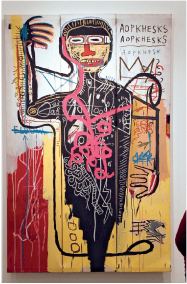
A woman looks at Jean Michel Basquiat’s “Portrait of the Artist as a Young Derelict” at the Modern Arts museum in Paris.
NOVEMBER 13, 1988
80’S DESIGN:
WALLOWING IN OPULENCE AND LUXURY
The architecture of the last decade has been marked by a consistently high level of concern for appearances; it has been lavish in its use of materials, active in its use of ornament, and highly dependent on the forms of history, particularly those of classicism.
This has been a decade—and here we come back, inevitably, to the fact of these having been the Reagan years—in which architecture has been luxurious, even sumptuous, but in which it has also been not a little self-indulgent. These have been great years for the marble shippers of Italy and the granite quarries of New England; the office buildings of the 1980’s have been celebrations of luxury such as we have not seen for half a century. Opulence has been the order of the day—from the A.T.& T. Building by Philip Johnson and John Burgee in New York; to the same architects’ towers in Boston, Chicago, Houston and Dallas; to buildings such as Kohn Pedersen Fox’s Procter & Gamble headquarters in Cincinnati, Edward Larrabee Barnes’s Equitable Tower in New York, and Skidmore, Owings & Merrill’s modestly named One Magnificent Mile in Chicago.
Some of these buildings have been good and some of them have been terrible, but taken as a group, the good and the bad present a remarkable sense of a time concerned primarily with recapturing a sense of lavishness from the past.
Post-modernism began, after all, a decade or more before the Reagan era, with the work of such theorists as Robert Venturi, who one presumes would be appalled to think of any connection between his ideas and the conservative tastes of the Reagan years. He was arguing against the utopianism of modernism, and against its austerity and indifference to popular taste; his alternative, of course, was a highly studied architecture that comments ironically on the architecture of the past and, in its irony, asserts itself firmly as work of our time.
Post-modern architects began by looking at the past to seek to express connections to a broader culture that modern architecture had denied them; by the mid-1980’s, many of them were looking back just for the ease and comfort of it. The career of Robert A. M. Stern stands as a perfect example of this: a student of Robert Venturi, Mr. Stern in the 1970’s sprinkled his work with Venturiesque irony. But in the 1980’s he became more and more a designer of lavish, highly traditional houses for the well-to-do; he moved from commenting on the Shingle Style to attempting to echo its forms literally. In the last couple of years, Mr. Stern has designed sumptuous Georgian and Shingle Style mansions that could almost pass for leftovers from the 1920’s.
OPPULENCE HAS BEEN THE ORDER OF THE DAY
Perhaps the real design symbol of these years has not been Philip Johnson or Robert Stern but Ralph Lauren, who produces impeccable stage sets of traditional design; they exude luxury and ease. Ralph Lauren has become a kind of one-man Bauhaus, a producer of everything from fabrics to furniture to buildings, all of which, taken together, form a composite, a fully designed life. But where the Bauhaus sought to challenge established standards, to break out of the bourgeois symbols of the age, Ralph Lauren celebrates them. Design is not a matter of challenge but of comfort.
The challenge of the next decade will not be to supplant post-modernism but to bring it back to its beginnings—to try to re-establish the connection between post-modernism and seriousness of intent that Robert Venturi gave it in its beginnings, while not losing sight of the social goals that have become more important in the last couple of years. It is not an easy agenda—but there never was anything easy about making architecture in the real world, in this time or any other. 
Pei Pyramid and New Louvre Open Today
PARIS, March 25–Not since Gustave Eiffel made the first climb to the top of his tower 100 years ago has the inauguration of a structure in Paris been as eagerly awaited as the opening of I. M. Pei’s glass pyramid in the middle of the courtyard of the Louvre.
And Wednesday afternoon, more than five years after the unveiling of its design provoked international controversy and accusations that an American architect was destroying the very heart of Paris, President Francois Mitterrand is to quietly snip a ribbon, officially opening the pyramid.
The news from Paris is that the Louvre is still there, although it is now a dramatically different museum. The pyramid does not so much alter the Louvre as hover gently beside it, coexisting as if it came from another dimension.
The pyramid itself is a technological tour de force: it is exquisitely detailed, light and nearly transparent. Yet it is also a monument intended to take its place in the city’s grandly scaled urban fabric, a structure that, for all its overt modernism, has a strictly geometric formal quality that ties it to the Parisian cityscape.
The story of this 71-foot-high structure of glass and metal, which now serves as the main public entrance to a significantly remodeled Louvre, bears other resemblances to that of the Eiffel Tower. Like the tower, the pyramid was at first bitterly denounced by many prominent people in the arts, who viewed it as an unwelcome intrusion of harsh modernism into the sacred precincts of Paris. But also as with the tower, the Parisian mood mellowed as construction proceeded. Now that the pyramid is finished, its sharpest critics seem to have retreated, and it has become fashionable in this city not only to accept the building but even to express genuine enthusiasm for it.
The vast new underground Louvre contains a 29-foot-high main hall beneath the glass pyramid, shops, cafeterias, an auditorium and education and information facilities for visitors, and storage and work areas for the staff.
Beginning Thursday, the first day the public will be admitted to the renovated Louvre, visitors will enter the museum through the pyramid, stopping first on a triangular ground-level entry platform, then descending via an escalator, a spiral staircase or a round open platform elevator to the new main vestibule, called the Hall Napoleon. 
JUNE 14, 1989
CORCORAN, TO FOIL DISPUTE, DROPS MAPPLETHORPE SHOW
The Corcoran Gallery of Art has canceled a planned retrospective of the work of the photographer Robert Mapplethorpe, anticipating that its content would trigger a political storm on Capitol Hill.
“Robert Mapplethorpe: The Perfect Moment,” an exhibition of more than 150 works, many of them explicit homoerotic and violent images, was partly financed with a grant of $30,000 from the National Endowment for the Arts, an agency already under fire from Congress for its grant policies. The exhibition was to have opened on July 1.
“Citizen and Congressional concerns—on both sides of the issue of public funds supporting controversial art—are now pulling the Corcoran into the political domain,” said the director of the Corcoran, Dr. Christina Orr-Cahall.
Organized by the Institute of Contemporary Art at the University of Pennsylvania, the show has appeared in Philadelphia and Chicago, and is to travel to Hartford; Berkeley, Calif.; and Boston. Another extensive exhibition of Mapplethorpe’s work was on view last year at the Whitney Museum of American Art in Manhattan. The photographer died of AIDS in March at the age of 42.
Dr. Orr-Cahall said that the gallery had not yet received Congressional pressure, but that gallery officials had been “monitoring” the situation and felt that a major Congressional dispute was shaping up over the National Endowment’s support of the exhibition. The Corcoran received $292,000 in Federal funds in 1988 and the gallery is involved in a campaign to increase its endowment from $2 million to $12.5 million.
The controversy comes at a time when the arts endowment’s budget is up for review and it faces reauthorization legislation. The endowment has been severely criticized in recent months by members of Congress regarding a grant made to an artist through the Southeastern Center for Contemporary Art. The work under fire, by Andres Serrano, is a photograph of Christ on a crucifix submerged in the artist’s urine.
Senator Alfonse M. D’Amato, Republican of New York, took to the floor of the Senate on May 18 to express outrage. Twenty-five members of the Senate, across the political spectrum, co-signed a letter written by Senator D’Amato to Hugh Southern, the acting chairman of the arts endowment, asking that the endowment change its procedures.
Senator Jesse Helms, a Republican of North Carolina, joined with Mr. D’Amato on the Senate floor in expressing his outrage over the Serrano photograph and “the blasphemy of the so-called artwork.”
“I’m appalled by the decision,” said the director of the Washington Project, Jock Reynolds. “It is an outright cave-in to conservative political forces who are once again trying to muzzle freedom of expression in the arts. The Corcoran should look to the inscription that is carved over its entrance: ‘Dedicated to Art.’ They should stand by their motto and let Mapplethorpe’s work speak for itself.”
APRIL 5, 1981
London Literary Life; Let Me In, Let Me In!
Not long ago, I traveled to Cambridge to give a reading from a novel I had just published. In the pub afterward, surrounded by pleasantly deferential students, I was asked about the London literary world. The students’ preconceptions about London were, of course, as naive and fantastic as were mine about Cambridge: “Is Clive James really a millionaire? Do you know Angus Wilson? Is Ian McEwan really having an affair with Princess Margaret?” I exaggerate, but the questions all presupposed a febrile metropolis of vast monetary gain, blazing celebrity and keen socio-sexual selfbetterment.
The London literary world does not exist. The London literary world is chimerical. “I am a chimera,” I always think, when people assume I belong to it. The London literary world is a collective fantasy of eager literary aspirants, and the fantasy contains strong elements of paranoia.
Years ago I made the mistake of writing the “One Man’s Week” guest column in the London Sunday Times. In this article I described a regular London lunch which is informally attended by myself, one or two novelists, a cartoonist, the odd poet and assorted literary layabouts. The piece was written in terms of comic hyperbole’a London literary lunch as it might be imagined by, say, an embittered provincial schoolmaster with a crate of unpublished novels in his garden shed. Under the restaurant’s sparkling chandeliers, the assembled tricksters and careerists gorged themselves on expensive food and drink, offering bribes to venal literary editors, crafting ecstatic reviews of each other’s books, condemning rivals to obscurity, hollering at the waiters, staggering out drunk at 5 o’clock, and so on.
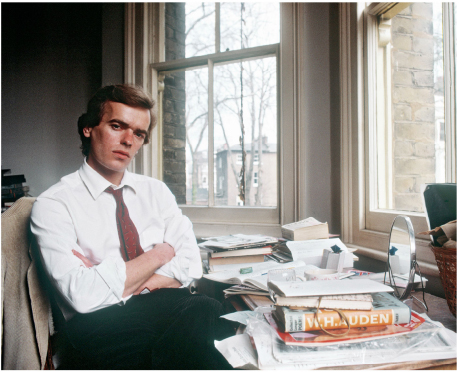
Martin Amis poses at home on September 25, 1987, in London, England.
Practically everyone took the piece seriously as a confession or a boast. At last, people thought, they’re coming out into the open.
“I was only kidding,” I pleaded but to no avail. In a sense, the lesson of this literary sketch, and its attendant hate mail, is an old one: Never overestimate the obviousness of your own irony. But perhaps the response also reflects a general hunger to believe in an elite that coldly excludes oneself. Would-be writers may actually prefer to think of the London literary world as a hive of toadyism and malpractice. Such an impression adds considerable poignancy to the presupposition of neglect.
In the British view of the trans-Atlantic literary world, the beleaguered poets and novelists of America live in turreted fortresses or are reduced to spectral, subterranean existences. This version exaggerates reality, but suggests real differences too. When Norman Mailer published “The Naked and the Dead,” he instantly saw himself as “a node in a new electronic landscape of celebrity, personality and status.”
But there is no such landscape in England. There can be no more than half-a-dozen serious British writers who could live by their books alone. We are always forced out into the world mainly because we are looking for extra work. Here we tangle with the odd overzealous fan, and with each other; but there is no feeling of intellectual community or consensus. We are just a lot of people writing in rooms and meeting occasionally for lunch. 
MARCH 2, 1980
THE PACKAGING OF JUDITH KRANTZ
In a publishing world worried about huge sums paid to popular writers, the author of “Scruples” has sold the reprint rights to her novel, “Princess Daisy,” for a record $3.2 million.
PULITZER NOVEL’S PUBLICATION IS TALE IN ITSELF
NEW ORLEANS, April 14–“I don’t like fame,” 79-year-old Thelma Toole said. “But I’m happy for my son.” Her unrelenting belief in the writing of John Kennedy Toole, her late son, led to the publication last year of a manuscript over which he had toiled for years and, yesterday, to the crowning of his work with a Pulitzer Prize for fiction.
“I was in a transcendental mood because I had tried for so many years,” Mrs. Toole, a retired teacher of the dramatic arts, said in summing up nearly 15 years of struggle that resulted in the publication of the book, a comic novel about life in New Orleans entitled “A Confederacy of Dunces.”
The book was praised in The New York Times Book Review as “a masterwork of comedy” and it was selected by The Los Angeles Times as one of the five best novels of the year. The Chicago Sun-Times called it “a foot-stomping wonder.”
The story behind this book is perhaps a familiar one, up to a point. It is of an unknown young writer convinced that he can be an author and of his romance with a New York publishing company. His inability to win publication is believed by his mother to have contributed to his suicide in March 1969 at the age of 32.
“It’s beautiful and it’s full of pain and anxiety,” Mrs. Toole said of the entire experience, ranging from the time her son presented her with a manuscript he wrote while in the Army through the very moments that she recalled the ordeal here today for a reporter, occasionally interrupting her account to answer the phone.
The time was in the mid-1960’s, when prospects were perhaps not the greatest for a manuscript focusing on the life of poor whites and their encounters with the rest of New Orleans society. But John Toole set out to have his manuscript published with one house only—Simon & Schuster.
The manuscript came to Robert A. Gottlieb, at the time an editor at Simon & Schuster. Mr. Gottlieb, now president and editor in chief of Albert A. Knopf, contacted this afternoon by telephone, said that he did not remember the man, the manuscript or the book.
As Mrs. Toole explains it, the writer-editor relationship kept her son John “on tenterhooks” for some months before he accepted repeated suggestions for manuscript changes by Mr. Gottlieb.
“Gottlieb would write and say the manuscript needed work but it still would not sell,” said Mrs. Toole.
After nearly two years, her son asked for the manuscript back. It sat dormant for nearly three years and in 1969, while in Biloxi, Miss., John Kennedy Toole died in his car of carbon monoxide poisoning. The death was ruled a suicide.
“After my son died, I took the manuscript and said to myself ‘something has to be done,’” said Mrs. Toole. She tried several other publishers but had no luck.
She then turned to the novelist Walker Percy, who was teaching a creative writing course at Loyola University in New Orleans. “I suppose I put forth such a fervent plea, I suppose he might have been touched,” said Mrs. Toole. A week later Mr. Percy sent a postcard praising the book. Eventually, he helped secure its publication by the Louisiana State University Press in Baton Rouge, the state capital, about 75 miles from here.
“When I got the book in my hand, I called Walker and said it’s so much richer,” said Mrs. Toole. “He said that was because it was in print.”
Mr. Percy said in a brief telephone interview today that the manuscript looked “physically shabby” when he received it and he at first felt he could get rid of Mrs. Toole in relatively quick order. But, he recalled, after he started reading the manuscript he could not put it down. “It didn’t take long to recognize that there was something of quality here although I admit I felt it was a book that would only have regional appeal,” said Mr. Percy. “Frankly I was astonished at the national response.”
Mr. Percy also said that, except for editing, few changes were made in the manuscript. The book is in its sixth printing, according to officials at L.S.U. Press, with sales exceeding 45,000 copies in hardback and paperback. The movie rights have been sold. 
OBITUARY
JUNE 19, 1982
JOHN CHEEVER IS DEAD AT 70;
NOVELIST WON PULITZER PRIZE
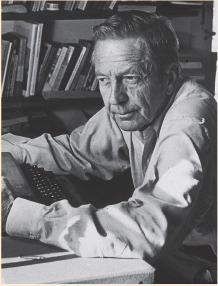
John Cheever at his home in Ossining, New York, October 1979.
John Cheever, whose poised, elegant prose established him as one of America’s finest storytellers, died yesterday at his home in Ossining, N.Y. He was 70 years old and had been afflicted with cancer for several months.
Long regarded by critics as a kind of American Chekhov, Mr. Cheever possessed the ability to find spiritual resonance in the seemingly inconsequential events of daily life.
In four novels, “The Wapshot Chronicle,” “The Wapshot Scandal,” “Bullet Park” and “Falconer,” and more than 100 short stories, he chronicled both the delights and dissonances of contemporary life with beauty and compassion.
It was an achievement recognized by a Pulitzer Prize, a National Book Award, a National Book Critics Circle Award and the Edward MacDowell Medal. Last April he also received the National Medal for Literature, in recognition of his “distinguished and continuing contribution to American letters.”
One of the few collections of short fiction ever to make The New York Times best-seller list, his collected stories published in 1978 established him as a writer with a popular audience as well. A new novella, “Oh What a Paradise It Seems,” was published by Alfred A. Knopf last March.
His voice was the voice of a New England gentleman—generous, graceful, at times amused, and always preoccupied with the fundamental decencies of life.
“The constants that I look for,” Mr. Cheever once wrote, “are a love of light and a determination to trace some moral chain of being.”
Flooded in light—river light, morning light and late autumn light—his stories were also illuminated with a spiritual radiance. Indeed, for all his meditations on the sad, sometimes humorous inadequacies of modern America, Mr. Cheever was, at heart, a moralist, concerned with what he called “the enduring past” and the nostalgia created by memory and desire.
OCTOBER 10, 1982
A TALK WITH DON DELILLO
During the last 11 years Don DeLillo has published seven novels of wit and intelligence. He has examined advertising (“Americana,” 1971), football (“End Zone,” 1972), the rock music scene (“Great Jones Street,” 1973), science and mathematics (“Ratner’s Star,” 1976), terrorism (“Players,” 1977), the conventional espionage thriller (“Running Dog,” 1978) and, in his new novel, “The Names,” Americans living abroad.
Yet despite his unusual versatility and inventiveness, it seems that relatively few readers other than the critics clamor for Mr. DeLillo’s work. He is able to earn a living from his writing, but he has not had a large commercial success.
“I don’t know what happens out there,” he says. “I don’t know how the machinery works or what curious chemical change has to take place before that sort of thing happens. I wouldn’t speculate. I’ve always tried to maintain a certain detachment. I put everything into the book and very little into what happens after I’ve finished it.”
The best reader, is one who is most open to human possibility
Mr. DeLillo’s new novel explores how Americans work and live abroad. The protagonist, James Axton, a “risk analyst” for a company with C.I.A. ties, becomes obsessed with a bizarre murderous cult whose members select their victims by their initials.
Like “Ratner’s Star,” a book in which Mr. DeLillo says he tried to “produce a piece of mathematics,” “The Names” is complexly structured and layered. It concludes with an excerpt from a novel in progress by Axton’s 9-year-old son, Tap. Inspiration for the ending came from Atticus Lish, the young son of Mr. DeLillo’s friend Gordon Lish, an editor.
Critic Diane Johnson has written that Mr. DeLillo’s books have gone unread because “they deal with deeply shocking things about America that people would rather not face.”
“I do try to confront realities,” Mr. De-Lillo responds. “But people would rather read about their own marriages and separations and trips to Tanglewood. There’s an entire school of American fiction which might be called around-the-house-and-in-the-yard. And I think people like to read this kind of work because it adds a certain luster, a certain significance to their own lives.”
Mr. DeLillo believes that it is vital that readers make the effort. “The best reader,” he says, “is one who is most open to human possibility, to understanding the great range of plausibility in human actions. It’s not true that modern life is too fantastic to be written about successfully. It’s that the most successful work is so demanding.” It is, he adds, as though our better writers “feel that the novel’s vitality requires risks not only by them but by readers as well. Maybe it’s not writers alone who keep the novel alive but a more serious kind of reader.” 
MARCH 20, 1983
Directors Join the S.E. Hinton Fan Club
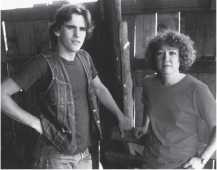
Matt Dillon with S.E. Hinton in the movie “Tex,” September 1982.
The novelist S.E. (Susan Eloise) Hinton has lived in Tulsa, Okla., for most of her 34 years. But these days she cannot help seeing her hometown as a giant movie sound stage. Three of her four books have been filmed in Tulsa in the last year and a half.
“Tex,” the first to be released, attracted good reviews last fall. “The Outsiders,” directed by Francis Coppola, opens in 800 theaters across the country on Friday.
Miss Hinton writes books for what is called the Young Adult market; her books have sold seven million copies to teenagers, and teenagers happen to be the core audience for movies these days. She is in demand because Hollywood believes that her stories can entice the kids who determine today’s blockbusters.
Both “Tex” and “The Outsiders” were turned into films because of pressure from Miss Hinton’s adolescent readers. A group of students in a California high school sent a petition to Francis Coppola stating that “The Outsiders” was their favorite book and nominating him to direct the movie version. Intrigued, Mr. Coppola asked his producer, Fred Roos, to read the novel, and Mr. Roos recommended it highly as a project for Mr. Coppola’s Zoetrope Studios.
Miss Hinton’s novelistic universe is a distinctive one. All four of her books are set in and around Tulsa, and they are unusual among teenage novels because of their sensitivity to class conflicts between rich kids and poor kids. In her stories the parents are largely absent; intense teenage friendships and sibling rivalries provide much of the dramatic material. Perhaps most surprisingly, all four books center on boys and are told from a male narrator’s point of view.
“That’s the point of view I’m most comfortable with,” Miss Hinton asserts. “When I was growing up, most of my close friends were boys. In those days, girls were mainly concerned about getting their hair done and lining their eyes. It was such a passive society. Girls got their status from their boyfriends. They weren’t interested in doing anything on their own. I didn’t understand what they were talking about.”
The reason that Miss Hinton originally used her initials rather than her full name was that she didn’t want her readers to question the authenticity of her books by knowing the author was a woman. When Matt Dillon first met her, he paid her what he thought was the ultimate compliment: “From reading your books, Susie, I thought you were a man.” 
APRIL 24, 1983
SOUTHERN ACCENT GARNISHES THE PULITZER PRIZES
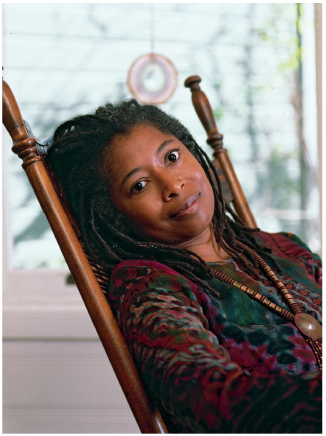
Pulitzer prize winning author Alice Walker, at her home in San Francisco, 1989.
Speaking with the same brutal honesty through characters seeking to control their own lives, two women of the South received Pulitzer Prizes last week—Alice Walker cited for a novel “at once political and spiritual,” and Marsha Norman for a “deeply moving” drama.
“I suppose what I was saying is this: Although we don’t get each other’s messages, we can still have faith in each other,” Miss Walker once said of her book, “The Color Purple.” The story concerns two black women: Celie, a child-wife living in the South, and her younger sister Netti, a missionary in Africa. Between world wars, they sustain themselves and each other by writing letters they never actually receive. The story focuses on Celie, at first a poor girl enslaved and abused by black men, in the end freed and endowed with a sense of self-worth by two rebellious black women. Miss Walker is the first black woman to win the fiction award.
Jessie Cates understands herself too well at the start of Miss Norman’s play, “’Night, Mother.” That is why she is intent on suicide. But not before she makes her mother, Thelma, face the emptiness of their home and daily rituals. Self-revelation, here, is a double-edged sword infinitely reflected. Jessie discovers that her interior life is “lost” but still hers to “stop, shut down, turn off,” while Thelma’s awakening to her daughter’s condition acknowledges the inexorable logic of the suicide.
THE YOUNG AND UGLY
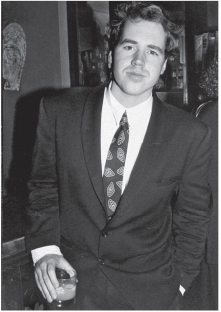
Bret Easton Ellis
LESS THAN ZERO. By Bret Easton Ellis. 208 pages.
This is one of the most disturbing novels I’ve read in a long time. It’s disturbing because the 20-year-old author draws a knowing portrait of adolescence that is almost entirely defined by hard drugs, kinky sex and expensive clothes. And it’s disturbing because these kids—who are as young as 13 and 14—are not only living a life out of a Harold Robbins novel, but have also acquired, at their brief age, a cynicism that makes, say, James Dean in “Rebel Without a Cause” seem like a Pollyanna.
According to the book jacket, Bret Easton Ellis is a student at Bennington College who grew up in Los Angeles, and his slick, first-person narrative encourages one to read the novel as a largely autobiographical account of what it’s like to grow up, rich and jaded, in Beverly Hills today. If Mr. Ellis’s story seems grossly sensationalistic at times—among the events described are a gang-rape of a 12-year-old girl—it also possesses an unnerving air of documentary reality, underlined by the author’s cool, deadpan prose.
The narrator, Clay, and his friends—who have names like Rip, Blair, Kim, Cliff, Trent and Alana—all drive BMW’s and Porsches, hang out at the Polo Lounge and Spago, and spend their trust funds on designer clothing, porno films and, of course, liquor and drugs. None of them, so far as the reader can tell, has any ambitions, aspirations, or interest in the world at large. And their philosophy, if they have any at all, represents a particularly nasty combination of EST and Machiavelli: “If you want something, you have the right to take it. If you want to do something, you have the right to do it.”
Mr. Ellis has a good ear for the sort of dumb exchange of non sequiturs, bad jokes and half-hearted shrugs that pass for conversation between Clay and his friends; and while his descriptions of Los Angeles carry a few too many echoes of Raymond Chandler, Joan Didion and Nathanael West—his novel contains all the requisite references to driving the highways, listening to the desert wind and watching beach houses slide into the sea—they nonetheless demonstrate a keen eye for grim details (the dead fish in the Jacuzzi, the cigarette butt stubbed out on the kitchen floor, and so on) and a sure sense of the absurd.
Still, “Less Than Zero” ends up feeling more like a “60 Minutes” documentary on desperate youth than a full-fledged novel. Its narrative, told in fast-paced, video-like clips, devolves into a litany of predictable scenes involving sex, drugs and rock-and-roll. And the characters remain so alike in their aimlessness and disaffection that the reader has a pretty hard time of it telling them apart.
Mr. Ellis clearly possesses talent—and the drive to do something with his gifts. Perhaps in his next novel, he will bring them to real fruition—and write a story that doesn’t merely depress us with sociological reports, but also moves us with the force of its imaginative transactions. 
OCTOBER 13, 1986
IN PUBLISHING, THE NAME IS THE GAME
A glace at yesterday’s New York Times bestseller list shows that 7 of the top 15 nonfiction books were written by people best known for something other than writing.
There are five autobiographies: “Mayflower Madam,” by Sydney Biddle Barrows, with William Novak; “Snake” by Ken Stabler, the retired Oakland Raiders quarterback, and Berry Stainback; “I, Tina,” by the singer Tina Turner, with Kurt Loder; “Mc-Mahon!,” by Jim McMahon, the quarterback for the Chicago Bears, with Bob Verdi; and “And So It Goes,” by Linda Ellerbee, the television commentator. The other two books are less memoirs than meditations: Bill Cosby on being a parent (“Fatherhood”) and the former Oakland Raiders coach John Madden (with Dave Anderson) on—what else?—football (“One Knee Equals Two Feet”).
Also recently published or forthcoming are autobiographies by Gelsey Kirkland, Jose Napoleon Duarte, Hugh Downs, Joan Baez, Alicia Markova, Jill Ireland Bronson, Phil Niekro, Liberace, Carol Burnett, Eugene McCarthy, Joan Sutherland, Franco Zeffirelli, Margaret Whiting, Mary Wilson and Joe Montana.
Certainly this People magazine approach to publishing isn’t an entirely new phenomenon, and in cases where the individual possesses a substantial story or literary gifts (or, most happily, both), the result can be a compelling book. Many of these new autobiographies by public figures, however, are little but slapped-together narratives, designed to be sold—like sportswear or cosmetics—on the basis of their author’s fame.
Because such books are frequently written with a ghostwriter or collaborator, the bylines that appear on a given title page can take oddly convoluted forms: “Football for Young Players and Parents” was written “by Joe Namath,” “created and produced with Bob Oates Jr.,” with “illustrations by Todd Treadway,” and “special photography by Rob Brown.” And the mystery-thriller “Murder at the Super Bowl” was written by Fran Tarkenton with Herb Resnicow, from a “concept by Bill Adler.” Such a litany sounds more like the roll of credits on a movie than the byline of a novel—a form once regarded as the supreme province of the individual writer’s voice. But given publishers’ new emphasis on packaging—and the apparent belief that anyone can write a book—it probably won’t be long before we see novels crediting assistants for such matters as stunts, special effects and maybe even additional dialogue. 
NEW YORK’S SPINNING LITERARY CIRCLES
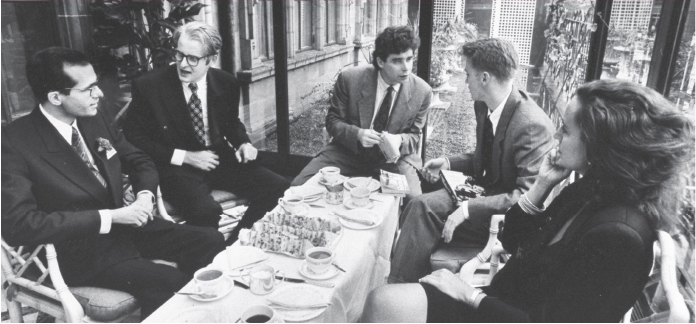
American novelist, Jay Mclnerney (center) having afternoon tea with reporters from “Private Eye” and publicist Caroline Michel (right) in 1988.
A writer’s life may be one of dreary solitude, but the Literary Life—ah, the Literary Life promises glamour, fame, a seat next to Hemingway as he scribbles immortal prose in a Paris cafe. The myth is so alluring it can survive even the most scaled-down atmosphere. On a typical New York night, for instance, David Leavitt, Meg Wolitzer and Gary Glickman—all novelists in their 20’s and the best of friends—are likely to be having dinner at their favorite restaurant, a dingy, hole in the wall in the West Village. “Even as we sit there,” Glickman says, “I sometimes wonder, ‘Is this it? Is it the Cafe de Flore?’” As Hemingway might have said, isn’t it pretty to think so?
A different twist on the literary life in 1980’s New York clubs replacing cafes, and roaming bands of authors stalking the night streets from Area to Palladium to Nell’s. Jay McInerney’s best-selling 1984 novel, “Bright Lights, Big City,” with its aspiring-writer hero, created a hip New York where late-night clubs and cocaine blurs collide with literary ambition. Tama Janowitz’s “Slaves of New York,” published last year, carries on the image, in stories full of struggling artists, devious gallery owners, desperate hangers-on, all willfully imprisoned by their need to be trendy in the city. But these muddled, hard-partying characters—when would they ever find the time, or the clearheadedness, to write?—are fictional exaggerations.
In reality, for many young writers today, New York is a base where they can strive and grow until they become successful enough, or frustrated enough, to leave for a while—to spend the summer at a tranquil writers’ colony or to make money teaching for a year—always returning to replenish themselves in the literary waters, and hit some gossip-filled book parties to make contacts with editors, agents and publishers.
There is a dense network of overlapping circles, formed from tiny cells: Jay McInerney and his friends, the flashy, successful editors Gary Fisketjon, and Morgan Entrekin; the trio of precocious whiz kids, Leavitt, Wolitzer and Glickman—whose first novel, “Years From Now,” will be published this summer—and a larger clan of authors in their late 20’s and 30’s who have passed through Columbia University’s writing courses.
The glitzy image of New York as a club-filled amusement park is not pure hype, though, any more than it is the simple truth. Look at the video Tama Janowitz made. Billed as “the first literary video,” it was a brief commercial for “Slaves of New York” that appeared on cable television last fall. Tama, with her antique-shop, disheveled, early-Madonna look, is seen strutting down the street, dining with Andy Warhol and the rock star Debbie Harry, sitting in a pink crinoline skirt at a desk in the tiny Horatio Street studio apartment where she then lived. A voice-over that brings to mind “Life Styles of the Rich and Famous” entices viewers to read about: “New York’s art scene! The color! The characters! The relationships!” Is this Tama Janowitz’s life?
“Put it this way, I don’t wake up in the morning and put on a tutu and have makeup artists come over while I’m sitting there typing. Real life might be one day of me sitting there typing and just making some horrible dinner and then watching TV, and the next night might be the night I go to dinner with Andy,” she said a few months before the pop artist’s death. 
CHICAGO’S GRUMPY GURU
Until a few months ago, Allan Bloom was an obscure academic. Students of Plato knew him as the author of a highly idiosyncratic translation of “The Republic”; students of Rousseau may have used his translation of “Emile” in a college course. In 1983, Simon & Schuster had signed him up to write a book on the crisis in higher education, offering a $10,000 advance; if the book did well, they calculated, it might sell a few thousand copies. Four years later, “The Closing of the American Mind” made its way to the top of The New York Times best-seller list and stayed there for 10 weeks. By the time I arrived in Chicago, it had been on the list 31 weeks and sold close to half a million copies.
“The Closing of the American Mind” has provoked a fantastic amount of debate. Even now, 10 months after its publication, large-scale attacks continue unabated.
Bad reviews are one thing; the responses to Bloom’s book have been charged with a hostility that transcends the usual mean-spiritedness of reviewers. “How good a philosopher, then, is Allan Bloom?” demanded Martha Nussbaum, a classics professor at Brown.
“The answer is, we cannot say, and we are given no reason to think him one at all.” This was mild compared to the objurgations of David Rieff, a senior editor at Farrar, Straus & Giroux. Bloom, he charged, was an academic version of Lieut. Col. Oliver L. North: vengeful, reactionary, antidemocratic. “The Closing of the American Mind,” he concluded, was a book “decent people would be ashamed of having written.”
What is it about this book that kindles such fury? For one thing, Bloom isn’t so mild-mannered himself. In his survey of the American scene, he finds much that is contemptible. Contemporary students are ignorant; they don’t read books; they’re corrupted in adolescence by primitive rock music. One of Bloom’s most notorious images is of a hypothetical 13-year-old boy doing his math homework while listening to the “orgasmic rhythms” of a “drag-queen” (Mick Jagger) on his Walkman. “In short,” declares Bloom, “life is made into a nonstop, commercially prepackaged masturbational fantasy.” But it isn’t just “the young” who besmirch America; the culture as a whole is mediocre, “a Disneyland version of the Weimar Republic for the whole family.”
How does the university figure in Bloom’s scheme of things? His book is subtitled, “How Higher Education Has Failed Democracy and Impoverished the Souls of Today’s Students.” Like E. D. Hirsch Jr., whose “Cultural Literacy” was another unlikely book high on the best-seller lists for months, Bloom deplores the low standards that prevail on American campuses. Who’s to blame? College administrators, who’ve abdicated their civilizing role by acquiescing to the demand for “relevance.” Black studies, Deconstructionism, the popularization of German philosophy in the works of Herbert Marcuse and others: it’s all a plot to discredit what are called around Chicago the Great Books.
This fierce polemic is hedged about with a lot of very heavy philosophizing. For Bloom, the corruption of the modern world can be variously traced to Locke, whose theory of rights prepared the way for liberalism; to Nietzsche, whose critique of bourgeois culture was appropriated by the American left; to Heidegger, who gave philosophical credence to Nazism; and to many other intellectual villains, both witting and unwitting.
My theory is that Bloom appeals to the perennial student in so many of us’that yearning, after years out in the busy world, to restore for a brief moment the innocence of our undergraduate days, the long nights in the library spent struggling through “The Social Contract.” His book is about the joys of education: how to live in the world without losing one’s soul. Bloom is a Socrates figure; he wants to go among his pupils debating the great ideas. And Chicago is his Athens.
NOVEMBER 9, 1988
LESSONS
This is the year the term “cultural literacy” became part of cultural literacy.
First came E. D. Hirsch Jr.’s “Cultural Literacy: What Every American Needs to Know.” The book became a surprise best seller by arguing that American schoolchildren lack the basic information that is part of being an educated person. Too many of them, he said, think that the Alamo was a play by Homer or that the Great Gatsby was a magician.
Now Mr. Hirsch, a professor of English at the University of Virginia, has published “The Dictionary of Cultural Literacy,” a list of 7,500 cultural tidbits, from a cappella to zygote, that “form the common heritage of all literate Americans.” Still to come is a children’s dictionary and tests of cultural literacy for sixth and twelfth graders.
His first battle is with those who argue that the main purpose of education is to teach certain skills like reading, calculating and thinking, and that these skills can be taught in isolation from any particular content. That philosophy underlies both the “cafeteria” curriculums of the 1970’s and today’s movement toward “critical thinking.”
Mr. Hirsch1s second battle is with the cultural left, which has accused him of promoting prevailing American cultural values at the expense of information about non-Western cultures and the experience of women, ethnic minorities and other groups.
But Mr. Hirsch says that his critics confuse culture and politics. “I consider myself a political liberal because I want to give disadvantaged children the same opportunities that others have,” he said. “I’m all for evolution in the content of what educated people know.” 
For Morrison, Prize Silences Gossip

Toni Morrison in her office at Princeton University.
Responding to the first call yesterday afternoon informing her that she had won the Pulitzer Prize for fiction, Toni Morrison caught her breath, asked for a few minutes to form her thoughts, then said:
“I think I know what I feel. It’s true that I had no doubt about the value of the book and that it was really worth serious recognition. But I had some dark thoughts about whether the book’s merits would be allowed to be the only consideration of the Pulitzer committee. The book had begun to take on a responsibility, an extra-literary responsibility that it was never designed for.”
By “extra-literary responsibility,” Ms. Morrison was referring to the controversy surrounding a statement on her behalf, signed by 48 black writers and published in The New York Times Book Review last January. The statement, prompted by Ms. Morrison’s having not won the 1987 National Book Award, for which she had been a finalist, decried the fact that she had never won the Book Award or the Pulitzer Prize.
Literary figures agreed yesterday that “Beloved”, had won the Pulitzer Prize on its own much-deserved merits as a novel. Ms. Morrison herself said she believed that the award was made despite “gossip and speculation.,
“In the end I feel as though I have served the characters in the book well, and I have served the readers well, and I hope the Pulitzer people are as proud of me as I am of them,” Ms. Morrison said. 
FEBRUARY 16, 1989
IRANIANS PROTEST OVER BANNED BOOK

Demonstration against Salman Rushdie for his book “The Satanic Verses” in Paris, France, in November 1989.
Thousands of people reportedly threw stones and waved pictures of Ayatollah Ruhollah Khomeini outside the British Embassy in Teheran today in protest against a book that has been deemed offensive to Islam.
The demonstration came as an aide to Ayatollah Khomeini, the Iranian revolutionary leader, was quoted as offering a $1 million reward to anyone who killed the book’s author, Salman Rushdie. The reward was to be tripled if the killer was Iranian.
Mr. Rushdie’s novel, “The Satanic Verses,” has prompted violent protests this week by Muslims in India and Pakistan.
The police today were guarding Mr. Rushdie’s house in north London, as well as the offices of the book’s publisher, Viking Penguin. Telephone calls to Mr. Rushdie’s residence went unanswered, and the Press Association, Britain’s domestic news agency, said the author was believed to be in hiding with 24-hour armed police guards.
The official Iranian press agency quoted Fakhreddin Hejazi, a member of the Iranian Parliament, as telling demonstrators in Teheran that Britain was “the enemy of the Koran and Islam and the manifestation of all things evil.”
A spokesman in the British Foreign Office said the police in Teheran were out in force and kept the crowd across the road from the embassy.
Mr. Rushdie, a British subject, was born into a Kashmiri Muslim family in Bombay. Today was declared a day of mourning in Iran in protest against “The Satanic Verses,” which many Muslims contend is blasphemous.
Hojatolislam Hashemi Rafsanjani, the Speaker of the Iranian Parliament, was quoted by Iran’s press agency as saying that what had angered Ayatollah Khomeini was not “merely the publication of a book or novel against Islam.”
A Reuters report from Nicosia, Cyprus, said the Iranian state television had broken into a news broadcast to report that Hassan Sanei, an aide to Ayatollah Khomeini, had offered a reward to “anyone who would punish this mercenary of colonialism for his shameful act.”
ODE ON AN OED
THE OXFORD ENGLISH DICTIONARY Second Edition. Prepared by J. A. Simpson and E. S. C. Weiner. 20 volumes. 21,728 pp. New York: Clarendon Press/Oxford University Press. $2,500.
So here it is at last, the distinguished thing, and at 11.5 cents a page not really overpriced. For these pages average 2,300 words. Thus Stephen King’s hard-cover publisher charges more per word for phrasing far less meticulously thought out. “Meticulously”? That contains the Latin “metus,” fear, and it used to connote timid fussing such as you’d smirk at. But the Oxford English Dictionary’s dated citations permit you to watch as in the 20th-century meticulousness slides toward the admirable: “careful, punctilious, scrupulous, precise.”
All four of those words apply to any OED entry. Take “adamant,” which my favorite one-volume dictionary, Webster’s Ninth New Collegiate, disposes of in six lines. In the Oxford they accord it half a page, from which we learn that its Greek root means “untamable”; that Greeks and then Romans applied it to the hardest substances they knew of (ultimately the diamond); then that “early med.L. writers” got hung up on “adamare,” Latin for “to love deeply,” and took to using “Lapidem Adamantem,” the Attracting Stone, for the new-fangled magnet.
In the first edition, the citations for “adamant” stop at 1878, well before anyone was stating adamantly. That was because Oxford published the first part of “A” as long ago as 1884, and kept it locked in type. From then clear to 1928 the work emerged piecemeal, in units of (normally) 64 pages, collected by thrifty folk for future binding. By the time the whole dictionary was available in a 12-volume set (1933), so much new material had flooded in that the earlier portions were already obsolete. So the same year saw a supplementary volume; and when a second (four-volume) Supplement got added (1972-86), meticulous users found themselves consulting three alphabets. It was time, they decided at Oxford, to consolidate.
Briefly: with generous help from I.B.M.-United Kingdom Ltd., the whole huge bank of knowledge got computerized, the supplementary entries now made integral with what they’d once supplemented. Henceforward, no more of tacking new stuff on at the end. A novelty inserted in its proper place now nudges everything to its right further rightward. In the process some 5,000 new words (and new uses of old words) got added: “acid rain,” “daisy-wheel,” “Amex,” “Visa,” “CAT,” “brain-dead,” “dingbat”; the computerist’s sense of “Pascal,” the mathematician’s of “set.” I’ve made that all sound easier than it was. The keyboarding, subcontracted to a firm outside Philadelphia in Fort Washington, Pa., took 180 people 18 months. Custom software nicknamed Oedipus Lex (OED Integration, Proofing and Updating System) got written in England, while at the University of Waterloo, in Ontario, people devised the data base code to keep track of structural “tags,” more or less the elements typography sorts out on the page: pronunciations, etymologies, subdivisions of senses, instances ordered by date. At one stage the eyeglasses of fully five dozen proofreaders were being wiped with unreckonable Kleenexes. The result is so up-to-now it’s even captured “fax.”
Don’t think of it as a dictionary; think of it as five cartons, each about 10 by 16 by 12 inches and weighing 30 pounds, piled up on your doorstep by United Parcel Service, all the way from a warehouse in Fairlawn, N.J., four to six weeks after you order the Second Edition of the Oxford English Dictionary. All you have to do to cause this to happen is dial (800) 451-7556 and give Oxford University Press a credit card number that’s good for $2,500—the price of the 20 volumes—plus $75 for shipping charges. As of early this month, Oxford had sold 841 sets in the United States, out of the total print run of 10,000 sets.
The original 12 volumes of the First Edition, issued from 1884 to 1928, were sold by subscription in paperbound segments as they became available, and you can still have the First Edition in computer-readable form (on CD-ROM, I.B.M. compatible) from Oxford for $995. The First Edition is also still available photographically reduced into two large volumes of tiny type, magnifying glass included, for $27.95 through the Book-of-the-Month Club as a premium for joining, or from Oxford for $195.
There are no other ways of purchasing the new Second Edition—for the time being at least, it’s all or nothing at all.
But it may be possible to find discounts at local booksellers. One neighborhood store in Brooklyn, for instance, Bookcourt at 163 Court Street, will order it for you at 15 percent off—$2,125. 
MAY 11, 1989
‘Lonesome Dove’ Dispute Highlights Growth in Books on Tape
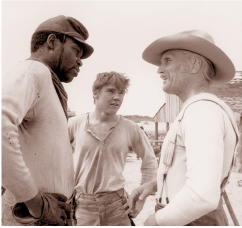
Aactors Danny Glover (left), Rick Schroder (center), and Robert Duvall in the television mini-series “Lonesome Dove.”
Larry McMurtry’s Pulitzer Prize-winning novel “Lonesome Dove” provided CBS with a mini-series that attracted large audiences earlier this year. Now a legal battle has erupted over rights to an audio version of the novel.
Simon & Schuster, which will publish the authorized audio version this year, has sued Dove Books-on-Tape, which has already shipped an abridged version of the soundtrack of the mini-series. Last week, Simon & Schuster, a division of Gulf and Western Inc., won a temporary restraining order prohibiting Dove from shipping its remaining 2,000 tapes.
The lawsuit, on the ground of copyright infringement, illustrates the growing importance of a publishing field that barely existed five years ago. The defendant, Michael Viner, co-owner of Dove Books-on-Tape, said he believed the suit was the first of its type in the fledgling industry.
Speaking of the industry’s annual revenues, Jim Milliot, executive editor for Knowledge Industry Publications, a research concern, said: “There are no hard numbers, no industry data, just seat-of-the-pants guesstimates. The ball park figure is $250 million in sales divided equally between retail and mail order.”
John Zinsser, who is in charge of audio book reviews for Publishers Weekly, estimates the size of the market for audio books—also known as spoken-word publishing—at $100 million in 1988, with fiction providing about 40 percent of the sales.
Mr. Viner, who started Dove Books-on-Tape in his garage six years ago with his wife, Deborah Raffin, an actress, said he expects $6 million in sales this year. Among Dove’s coming releases are the best-selling novels “The Joy Luck Club” by Amy Tan and “The Long Dark Tea-Time of the Soul” by Douglas Adams, read by the authors, and novelizations of the new movies “Batman,” read by the actor Roddy McDowell, and “Indiana Jones and the Last Crusade,” read by William Conrad. 
JULY 4, 1989
How Stories Written for Mother Became Amy Tan’s Best Seller
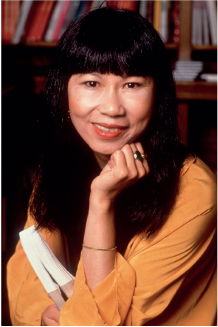
Amy Tan
Finding one’s voice in writing fiction is crucial for a beginning writer, but for Amy Tan, it seemed as if the voice found her first.
From the start, when she wrote the stories that eventually became her first novel, the best-selling “Joy Luck Club,” Ms. Tan said she felt as if she were merely taking dictation from an invisible storyteller.
“The Joy Luck Club” is a collage of interwoven stories told from the viewpoints of four Chinese mothers, members of the Joy Luck Club, a mah-jongg club, and their Chinese-American daughters. Unlike the eccentric characters in “Tripmaster Monkey,” Maxine Hong Kingston’s new novel about the Chinese-American experience, the women in “The Joy Luck Club” could belong to any immigrant group.
“The Joy Luck Club” has won glowing reviews, and paperback rights were sold to Vintage Books for $1.2 million.
I had always wanted to be a writer
Ms. Tan said she set out to write the stories for her mother to explain all the disagreements and turbulent moments of their lives together.
“When I was writing, it was so much for my mother and myself,” she said. “I wanted her to know what I thought about China and what I thought about growing up in this country. And I wanted those words to almost fall off the page so that she could just see the story, that the language would be simple enough, almost like a little curtain that would fall away.”
Ms. Tan’s relationship with her mother had deteriorated after the deaths of her father, an electrical engineer and Baptist minister, and her brother, both of whom died of brain tumors when she was 15. Her mother took her and a younger brother away from the “diseased” house to Europe and eventually settled in Montreux, Switzerland.
Ms. Tan crammed as many courses as she could into a year and graduated early from high school there. When they returned to the United States, settling in the Bay Area, Ms. Tan enrolled in Linfield College, a Baptist school in Oregon, one of two her mother had picked out for her. But Ms. Tan left the school to follow her boyfriend to San Jose State University and changed her major from pre-med to English.
Mother and daughter stopped speaking to each other for six months.
“My mother was convinced she had lost me,” she said. “I was so determined not to have anything to do with her.” Ms. Tan eventually married the boyfriend, Lou De Mattei, who became a tax lawyer. She received a master’s in linguistics.
“I had always wanted to be a writer,” she said. “I used to write little fantasy stories to myself. Sometimes I wrote these stories to friends in the guise of a letter. But I also had the practical sense that a person doesn’t make a lot of money being a writer, and I couldn’t do that except as an indulgence, as a hobby.”
Some of the details of her life have been woven into her book, like the discovery that her mother had left behind two other daughters, Ms. Tan’s half-sisters, when she came to the United States from Shanghai in 1949.
“It includes details of stories I’ve heard,” Ms. Tan said. She recalled one anecdote her mother told her about a friend who was fleeing from the Japanese in the war. “She had all these bags in her hands and she started dropping these bags along the road, one by one.”
That image later surfaced in the book in a story about a woman who, after dropping the bags of necessities and food, was finally forced, out of sheer fatigue, to leave her two babies along the road.
The author and her mother are closer, but Ms. Tan’s generational and cultural conflicts are a constant discovery process, she said.
“I think that if everything were neatly resolved,” she said, “I would have no more stories to write.” 
DECEMBER 27, 1989
SAMUEL BECKETT IS DEAD AT 83;
His ‘Godot’ Changed Theater
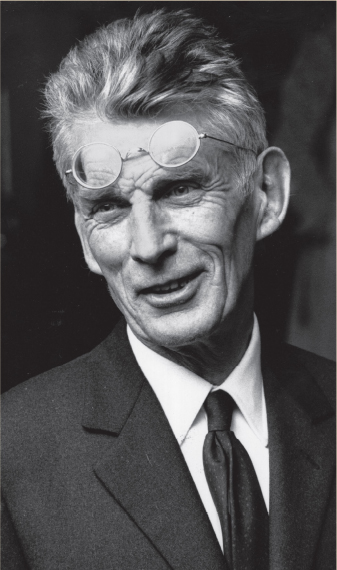
Samuel Beckett, a towering figure in drama and fiction who altered the course of contemporary theater, died in Paris on Friday at the age of 83. He died of respiratory problems in a Paris hospital, where he had been moved from a nursing home. He was buried yesterday at the Montparnasse cemetery after a private funeral.
Explaining the secrecy surrounding his illness, hospitalization and death, Irene Lindon, representing the author’s Paris publisher, Editions de Minuit, said it was “what he would have wanted.”
Beckett’s plays became the cornerstone of 20th-century theater beginning with “Waiting for Godot,” which was first produced in 1953. As the play’s two tramps wait for a salvation that never comes, they exchange vaudeville routines and metaphysical musings’and comedy rises to tragedy.
Before Beckett there was a naturalistic tradition. After him, scores of playwrights were encouraged to experiment with the underlying meaning of their work as well as with an absurdist style. As the Beckett scholar Ruby Cohn wrote: “After ‘Godot,’ plots could be minimal; exposition, expendable; characters, contradictory; settings, unlocalized, and dialogue, unpredictable. Blatant farce could jostle tragedy.”
At the same time, his novels, in particular his trilogy, “Molloy,” “Malone Dies” and “The Unnamable,” inspired by James Joyce, move subliminally into the minds of the characters. The novels are among the most experimental and most profound in Western literature.
For his accomplishments in both drama and fiction, the Irish author, who wrote first in English and later in French, received the Nobel Prize in Literature in 1969.
At the root of his art was a philosophy of the deepest yet most courageous pessimism, exploring man’s relationship with his God. With Beckett, one searched for hope amid despair and continued living with a kind of stoicism, as illustrated by the final words of his novel, “The Unnamable”: “You must go on, I can’t go on, I’ll go on.” Or as he wrote in “Worstward Ho,” one of his later works of fiction: “Try again. Fail again. Fail better.”
Though his name in the adjectival form, Beckettian, entered the English language as a synonym for bleakness, he was a man of great humor and compassion, in his life as in his work. He was a tragicomic playwright whose art was consistently instilled with mordant wit. As scholars and critics scrutinized his writing for metaphor and ulterior meaning, he refrained from all analysis or even explanation. As he wrote to his favorite director, Alan Schneider: “If people want to have headaches among the overtones, let them. And provide their own aspirin.” When Mr. Schneider rashly asked Beckett who Godot was, the playwright answered, “If I knew, I would have said so in the play.”
CLASSICAL MUSIC, OPERA, and DANCE
NOVEMBER 18, 1980
DARCI KISTLER BALLET DEBUT
Every so often—it happens about once a decade—George Balanchine singles out a very young dancer for special attention in his New York City Ballet. In the present instance it is the 16-year-old Darci Kistler, who joined the corps de ballet only last spring, but who was, most unusually, seen in a series of major debuts last weekend in Balanchine ballets at the New York State Theater.
The most prominent role was that of the ballerina in the second movement of “Symphony in C” on Sunday night. In the afternoon, she also danced for the first time as the supporting soloist in “Walpurgi snacht Ballet.”
This kind of exposure within the first year in a company is unorthodox for any dancer, not to speak of an inexperienced 16-year-old barely out of ballet school. Yet, as the past has shown, Mr. Balanchine does not take such chances lightly. The truth is that he is taking no chance at all—his own experience functions as a preselection process that zeroes in on foolproof potential. The very attention he pays to such a very promising few enables them to develop beyond their present capabilities.
Miss Kistler is a “natural” dancer. When she walks about the stage, she does so with a little lope, knees bent and on half toe. This coltish quality separates her from others in the Balanchine mold—and she is instantly recognizable as a Balanchine dancer. In other companies, her elongated line, fabulous leg extension and lunges into arabesque might be considered extreme departures from the norm.
Yet this kind of dancing serves the creative needs of a Balanchine ballet, and it was seen to best effect in “Walpurgisnacht Ballet.” Her harp solo looked newly lyrical, infused with a beautiful effortlessness, clearly shaped in every movement and firm in the jumps on toe. 
OCTOBER 25, 1981
PHILIP GLASS BREAKS THROUGH

Philip Glass
Five years ago, when it received its American premiere at the Metropolitan Opera, “Einstein On the Beach,” a controversial collaboration between the composer Philip Glass and the playwright-director Robert Wilson, exploded operatic conventions with amplified instruments played at rock-and-roll volume and a bizarre libretto of solfege syllables, counted numbers and stream-of-consciousness monologues. Hundreds in attendance at the two sold-out performances stalked out of the Met, handing their ticket stubs to hundreds of people waiting just as eagerly to get in.
Glass’s new opera, “Satyagraha,” which arrives at the Brooklyn Academy of Music on Nov. 6 for five performances with the Brooklyn Philharmonia, departs as radically as “Einstein” from much of the familiar ground of contemporary Western opera. The libretto, adapted from the Bhagavad-Gita—the inspiration for the political theory of “satya” (truth) and “agraha” (firmness)—is sung by six principals and a chorus of 40 in the original, vowel-rich Sanskrit.
Glass’s score—three hours of perpetual motion for voices, strings, woodwinds and electric organ—sustains the dreamlike serenity of the staging and language, with shimmering harmonies and super-Romantic melodic lines surfacing and submerging in cyclic variation. One long scene is based on 143 repeats of a simple fourchord progression, and, at another point, Gandhi wanders among his sleeping comrades, singing a scale from E to E, 30 times over.
But while Glass’s needle-in-the-groove compositions remain for some critics simply boring—or, worse, a form of sonic torture—serious musical appreciation of his work is growing, and so is popular acceptance. Several months ago, Glass signed the first exclusive composer’s contract with CBS Masterworks since Aaron Copland—and before Copland, Igor Stravinsky. Glass’s ability to bring together unexpectedly diverse audiences has resulted in one of the widest followings—and certainly the most eclectic—of any serious composer writing today.
THE DEARTH OF GREAT OPERA SINGERS
Many years ago, in the dawn of the Stereo Age, some farsighted impresario in the record business put out a series called “Opera Without Words.” An orchestra and a conductor whose names escape me at the moment performed voiceless versions of “La Traviata,” “La Boheme” and other popular favorites, presumably for the audience that liked operatic music but could not bear to hear it sung. At the time, some of us were already so sophisticated that we could not only listen to whole operas, voices and all, but detect the difference between Hans Hotter and Russell Oberlin. We whooped in derision at the oafs who bought and presumably played these wordless operas, which stood in connoisseur esteem just one level below records bearing such titles as “The Heart of the Concerto.”
Now, however, I wonder if opera without words may not have been an idea ahead of its time and one now worth reviving. That melancholy thought occurs in the wake of a couple of weeks of listening at the Metropolitan Opera, during which we had a “Norma” without a vocally plausible Norma, a “Siegfried” without a vocally plausible Siegfried and a “Butterfly” without a vocally plausible Butterfly.
Before the season is over, of course, we are bound to hear some voices that at least remind us of the real article. That might even happen tomorrow night when Birgit Nilsson visits the Met all too fleetingly in “Die Frauohne Schatten.”
The return of Miss Nilsson comes just in time to remind us that opera with words has not always been a hopeless notion. However, her presence also is a sobering reminder of how few genuine Wagnerians there have been during her generation and how dismal is the outlook right now for the immediate future.
Every voice enthusiast has reasons to offer for this famine, and they have been discussed often in these pages. Actually, the voice crisis is not confined to Wagner but extends to an older, grander style of operatic singing in general. Worth an especially respectful hearing is the opinion of J.B. Steane, whose “The Grand Tradition” is an astute account of the ups and downs of singing as reflected on recordings between 1900 and 1970. Mr. Steane thinks that the grandopera vocal style may not be dead and could even be starting to revive somewhat. But he contends that it is doomed unless composers go back to writing for the tradition and a new generation of young listeners finds something to value in the idea of vocal grandeur.
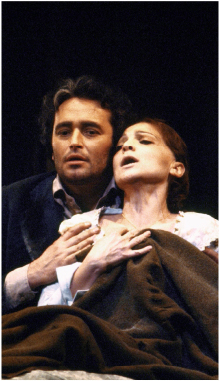
Tenor Jose Carreras as Rodolfo and soprano Teresa Stratas as Mimi in Puccini’s La Boheme on stage at the Metropolitan Opera.
“Perhaps consignment to the museum is the inevitable fate both of grand opera and the tradition of singing associated with it,” Mr. Steane says. Modern pop culture has given an entirely new meaning to singing, so that “to the average youngster the sound of the operatic soprano voice on records or television is now quite actively unpleasant: it sounds unnatural, being so high above the speaking voice, it sounds assertive, unfriendly and uncomfortably loud in its power, and its quality carries a mental image that is somewhat comical.” 
SEPTEMBER 28, 1983
JESSYE NORMAN IN WAKE OF A TRIUMPH
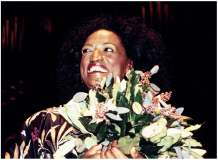
Jessye Norman
Jessye Norman celebrated her great success at the Metropolitan Opera’s opening night Monday with Chinese food and an hour and a half of sleep.
Her debut at the Met as Cassandra in Berlioz’s “Troyens” won over Monday night’s audience and Tuesday morning’s critics.
Berlioz kills off his Cassandra at the end of Act I, but the opera is so massive—five hours plus—that Miss Norman had plenty of room to make a grand impression during her time on stage. It is a vocally demanding role, but afterwards Miss Norman felt vocally healthy, “a little exhausted but very elated.” “I felt like I ought to go right out and sing it again,” she said.
For the current run of “Les Troyens” Miss Norman and Tatiana Troyanos will alternate in the roles of Dido and Cassandra. They will also cover for each other—that is, in case one is ill, the other will sing both roles. “At some point, I would really like to sing the two parts, and you do have a good half hour between the first- and second-act appearances,” said Miss Norman. “You’re so wound up after singing Cassandra, you feel like keeping on. And Dido is a very different kind of role; it’s much more lyrical and makes for a wonderful change.”
“I was finished by 9 o’clock, and my family and friends went across the street from Lincoln Center and had some lovely Chinese food,” Miss Norman said. “When we got back, the Met was still at it, and though they didn’t finish until well after midnight, it was lovely that so many people waited to the end to come back and see me.” 
BARYSHNIKOV PUTS HIS STAMP ON BALLET THEATER
When American Ballet Theater opens an unusually long season—11 weeks—tomorrow night at the Metropolitan Opera House, it will be the third year the company will be seen in New York with Mikhail Baryshnikov at the helm. As Ballet Theater’s artistic director since Sept. 1, 1980, Mr. Baryshnikov—to keep the nautical image—is still adamantly steering the course he first predicted. And yet he is, perhaps surprisingly, also willing to trim his sails.
He is, for instance, ready to accept that some criticisms of his controversial revisions of the 19th-century classics were well taken. In contrast to his statements in 1981, he is also less apt to mention Leningrad’s Kirov Ballet, his former company before he became a superstar in the West, as a reference point for his own stagings and concepts.
Asked to appraise his own first two and a half years as artistic director, Mr. Baryshnikov offered the following reflection: “The company is at the end of its first cycle of transition and it points to how I would like to see the company in the future. Stylistically, there have been some painful moments. When you work on style and you’re correcting all the time, it’s a pretty boring process. It’s like raising a child and you will see the result in five, six years.”
There have been some painful moments
To those who expected a clean sweep—a total break with the policies of Lucia Chase, the company’s previous director—the Baryshnikov line of advance might look like two steps forward, one step back. Nonetheless there are significant differences—a shift away from a looser artistic profile toward a stronger consistency regarding both repertory and style.
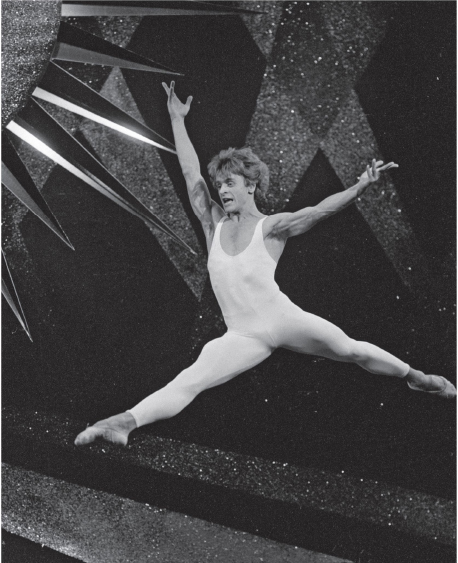
Mikhail Baryshnikov in 1981.
The cornerstone of Mr. Baryshnikov’s policy, as demonstrated in his first two seasons, is to turn Ballet Theater into an ensemble oriented troupe in which the ballet on view, rather than any individual dancer, is the chief attraction. This is clearly the most significant change in policy, although it has never been formally enunciated as such. In practice, it has meant a dilution in star impact among the principal dancers when younger dancers share their roles, and it has meant an increase in works that stress group choreography. Understandably this evolution, still in progress, has been a shock to a public that has its favorites (among whom Mr. Baryshnikov, willingly or not, is a top draw). 
MAY 1, 1983
GEORGE BALANCHINE, 79, DIES IN NEW YORK
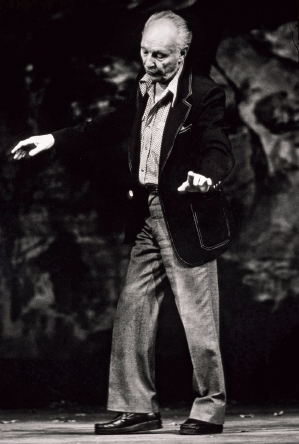
George Balanchine dancing in 1983.
George Balanchine, one of the greatest choreographers in the history of ballet and the co-founder and artistic director of the New York City Ballet, died yesterday.
Mr. Balanchine, who was 79 years old, died at Roosevelt Hospital of pneumonia, a complication that arose from a progressive neurological disorder.
In guiding the New York City Ballet to international pre-eminence, Mr. Balanchine established one of the foremost artistic enterprises the United States has called its own. As a 20th-century master, his personal contribution loomed even larger.
More than anyone else, he elevated choreography in ballet to an independent art. The plotless ballet became a synonym for Balanchine ballet. In an age when ballet had been dependent on a synthesis of spectacle, storytelling, decor, mime, acting and music, and only partly on dancing, George Balanchine insisted that the dance element come first.
In his dictum that the material of dance is dance itself, he taught dancers and the public to look at ballet in a new way. In his attraction to the very essence of dance—movement, steps and combinations of steps—he enlarged the ballet vocabulary as had no other 20th-century choreographer.
And because his choreography was so closely related to the music, a Balanchine work, in his words, became an invitation to “see the music and hear the dancing.”
Like Stravinsky and Picasso, the 20th-century modern artists with whom he has been ranked, Mr. Balanchine was an innovator who came out of a classical tradition.
The hallmark of the Balanchine style was, indeed, its conscious use of tradition as a base. The idiom in which Mr. Balanchine chose to work was the 400-year-old academic movement vocabulary he had learned as a child in his native Russia at the Maryinsky Theater.
It was at this imperial theater in St. Petersburg that the 19th-century French-Russian choreographer Marius Petipa created his greatest works, including “The Sleeping Beauty.”
Tradition was the base for renewal, and radical innovation could come only from those steeped in tradition. This belief was central to Mr. Balanchine’s work, and it was reiterated in print by Lincoln Kirstein, the distinguished dance scholar who became Mr. Balanchine’s patron and co-founder of the City Ballet and its precursor companies.
Together they established the School of American Ballet in 1934 and embarked on a venture that helped raise ballet to the highest status it has ever enjoyed in the performing arts.
The result was a creative output that raised the total of major Balanchine ballets to more than 200, only a few of them dating from the choreographer’s years in Russia or in Serge Diaghilev’s Ballets Russes and other European companies.
Throughout his career in the United States, the clarity of Mr. Balanchine’s artistic vision remained remarkably consistent. The goal was a school and an American Classical company with its own new works rather than 19th-century classics and revivals.
The museum concept was ruled out. Spectacle would be subordinate to dancing.
It was a commonplace to say that Mr. Balanchine choreographed better for women than men. There was no doubt that he believed his own often-repeated remark that “ballet is woman.” Whether they were trained by him or not, a galaxy of ballerinas would always be identified with his works or the City Ballet. Among them were Miss Tallchief, Marie Jeanne, Miss LeClercq, Melissa Hayden, Patricia Wilde, Diana Adams, Allegra Kent, Violette Verdy, Patricia McBride, Kay Mazzo and Suzanne Farrell.
In a remarkable summation of his beliefs in this matter and in his attitude toward life, Mr. Balanchine gave the following interpretation of his “Don Quixote,” in which he had once cast himself as the Don and Miss Farrell as Dulcinea:
“My interest in ‘Don Quixote’ has always been the hero’s finding something to live for and sacrifice and serve. Every man wants an inspiration. For the Don, it was Dulcinea. I myself think that the same is true in life, that everything a man does he does for his ideal woman. You live only one life and you believe in something, and I believe in that.”
AUGUST 18, 1983
IRA GERSHWIN, LYRICIST, DIES;
SONGS EMBODIED BROADWAY
Ira Gershwin, the lyricist who collaborated with his brother, George, on the scores for Broadway musicals that included “Porgy and Bess” and “Of Thee I Sing,” died yesterday at his home in Beverly Hills, Calif. He was 86 years old.
Mr. Gershwin, who wrote the lyrics of such Gershwin brothers songs as “Embraceable You,” “Strike Up the Band,” “The Man I Love,” “ ‘S Wonderful,” “Somebody Loves Me” and “I Got Rhythm,” had a heart disease and had been in frail health for several years. He died in his sleep.
His biographer, Robert Kimball, said yesterday that Mr. Gershwin had been unable to attend the Broadway opening last spring of the hit musical “My One and Only,” whose score relies entirely on George and Ira Gershwin songs from other shows.
Although he was best known for his collaboration with his brother, Mr. Gershwin also furnished lyrics for Kurt Weill’s songs for “Lady in the Dark,” Harold Arlen’s compositions for the musical remake of the movie “A Star Is Born,” and Jerome Kern’s songs for the movie “Cover Girl.”
The Gershwin brothers’ “Of Thee I Sing,” in 1932, was the first musical, and Mr. Gershwin the first lyricist, to win a Pulitzer Prize for drama. The show’s memorable score included the songs “Who Cares?” and “Love Is Sweeping the Country.” Mr. Gershwin was also a member of the Songwriters Hall of Fame.
The words written by Mr. Gershwin to accompany the music of some of the leading song composers of the time had a wit, polish, freshness and depth of feeling that set them far above the ordinary run of popular lyrics.
Collaborating with his brother, Mr. Gershwin wrote the words for such songs as “Our Love Is Here to Stay,” “Oh, Lady Be Good,” “They Can’t Take That Away From Me” and “Funny Face.”
With Kurt Weill, in addition to “Lady in the Dark,” he wrote the musical show “The Firebrand of Florence,” and with Arthur Schwartz he wrote “Park Avenue.” In Hollywood, he worked with Jerome Kern on the outstanding score for “Cover Girl.”
For many years, Mr. Gershwin lived in the shadow of his younger brother, whose music had captured the imagination of America. Ira used the name “Arthur Francis” to avoid confusing matters.
For five years, beginning in 1920, whenever anyone wanted to meet the nebulous “Arthur Francis” who wrote such wonderful lyrics, George Gershwin would reply, “Mr. Francis is too busy working to be disturbed,” and let it go at that.
Finally, in 1924, George Gershwin admitted that he had a brother who worked with him, and for the first time the billboards on Broadway proclaimed a show by the team of George and Ira Gershwin. It was the smash hit “Lady Be Good.”
There followed in rapid succession “Tip Toes,” “Oh Kay,” “Funny Face,” “Rosalie,” “Treasure Girl,” “Show Girl” and “Girl Crazy.” The titles conformed to a George Gershwin superstition: They should have not more than two words and should, if possible, have something to do with a girl.
JUNE 13, 1984
BAUSCH TROUPE MAKES NEW YORK DEBUT
The word was out, the place was mobbed. Pina Bausch, from West Germany, is the most talked-about choreographer in Europe and it was obvious that her reputation had preceded her at the Brooklyn Academy of Music last night, where the Pina Bausch Wuppertaler Tanztheater made its New York debut.
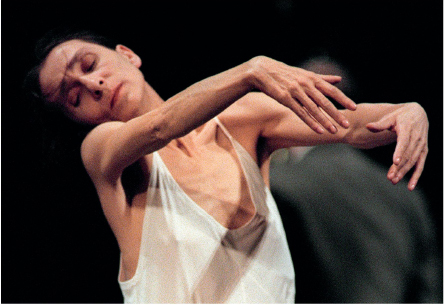
Pina Bausch
When the last blackout eclipsed the final moment in her version of “The Rite of Spring,” the mostly young audience rose to give the 43-year-old Miss Bausch and her company a cheering ovation. This first program, which opened with Miss Bausch’s theater piece, “Cafe Müller,” is one of three that will be on view during the company’s two-week run at the academy.
Miss Bausch is a major talent and an exciting one. This is clear even from a program that was designed by the academy to ease us gently into Miss Bausch’s more extreme experiments. Anyone who has followed her career through the European press can expect talk of real police dogs ringing a stage, stuntmen dropping four stories to the ground, dancers performing in tanks of water and stages filled with women in lingerie.
Her view of Stravinsky’s “Rite of Spring,” although performed on a dirt-covered floor, turns out, however, to be a recension rooted in a conventional idea, the battle of the sexes. And “Cafe Müller,” with its imagery of emotional pain, most of it self-inflicted, would not be startling to anyone familiar with Expressionist forms, Italian films about couples unable to communicate or both.
The performers are exceptional. Their hallmark is to avoid recognition of each other on stage and as Dominique Mercy and Beatrice Libonati hurl each other against a wall or repeatedly fall out of an embrace, they do so nearly as strangers. Their lips meet but whether they kiss is another matter.
When Jean Sasportes crashes through the furniture, he seemingly goes unacknowledged, and his destination is always undefined. When Meryl Tankard’s fearful scurries dot the action, she too becomes an unimportant bystander. In Jan Minarik, Miss Bausch—whose background solos serve as an abstraction of the drama—has a powerful perfomer who needs only to stand still to hold the stage. 
NOVEMBER 30, 1984
MARK MORRIS,
A New Force in Dance World, Hurtles on Stage
“Mark Morris: The Next of the Major Moderns?” a dance magazine trumpeted recently on its cover. Mr. Morris, a 28-year-old choreographer now based in his hometown of Seattle, first engaged New York audiences in 1980, when he showed his dances in one of the city’s downtown studio spaces. This weekend, he and his dancers are performing in the Brooklyn Academy’s prestigious Next Wave Festival—recognition of the fact that Mr. Morris is now considered one of the most gifted choreographers of his era.
His dances are musical, intelligent, lushly physical and informed by an endearing mixture of flamboyance and humanity. They also tend to defy categorization. This weekend, for example, audiences will see his “Gloria,” a richly textured pure-dance piece; “O Rangasayee,” a 20-minute workout of a new solo for himself set to music by Sri Tyagaraja; and his new “Championship Wrestling After Roland Barthes,” a group work set to synthesizer music composed by Herschel Garfein.
The first two dances were inspired, typically, by music. Mr. Morris had been carrying the Vivaldi score around in his head since his high school days, when he sang in a choir, studied ballet and flamenco and immersed himself in Balkan folk dancing, which he performed from the age of 14. At 20, he left Seattle for New York, where he found work with the companies of such choreographers as Eliot Feld, Twyla Tharp, Lar Lubovitch and Hannah Kahn.
Mr. Morris returned to Seattle last year so that he could work more spontaneously and informally. How does he feel about being the possible crown prince of modern dance? “I need a manager in a raccoon coat,” he says ruefully.
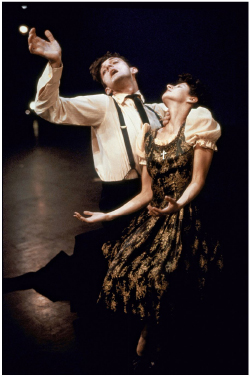
Mark Morris & Teri Weksler in scene from Mark Morris Dance Group performance of “One Charming Night” in 1985.
PAVAROTTI REFLECTS UPON THE CELEBRATED VOICE
Opera has known careers as remarkable as Luciano Pavarotti’s, but not many, and rarely more than one in any generation. The beloved Italian singer approached last night’s Metropolitan Opera opening as a star not only at the top of his profession, but one who has reached beyond it to a public not normally concerned with opera. He has taken his knocks, as well as garnering his laurels, along the way.
On a recent morning before the rehearsals for last night’s “Tosca” at the Met, Mr. Pavarotti sat in the bare studio of his large Central Park South apartment and talked about age, the future, the lonely profession of opera—and, naturally, “the voice.”
Mr. Pavarotti is approaching his 50th birthday (Oct. 12) and his 25th anniversary in opera, and “the voice” that represents opera to the world at large is still basically fresh and lyrical.
In a generation when too many singers reach their half-century in the grip of wobble, souring of tone and general distress, the only really significant change in the Pavarotti sound has been a certain erosion of the high notes. For some years now, he has avoided the high C that he used to deliver nine times in a single aria in “Daughter of the Regiment.”
A bout of vocal trouble did shadow the Pavarotti career a few years back—not the crisis that some singers undergo, but enough to cause concern. The singer was quite frank about its cause: “I took too many sleepy pill. It should make you sleep and recuperate, but when you take them every day as I did, there comes una sonnolenza nelle corde vocale—the vocal cords were sleepy. One day the sound was not so good, the next day worse. But it is now three years that I don’t take any. I don’t sleep as good, but I feel very healthy.”
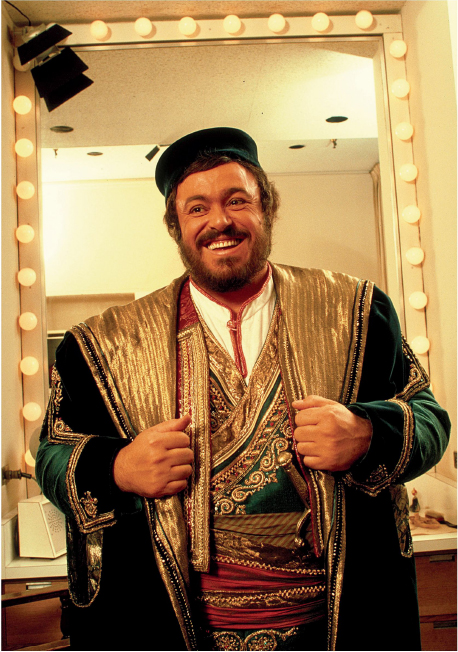
Luciano Pavarotti before a performance.
However healthy, though, Mr. Pavarotti is at the stage where any singer must begin to reflect on the fact that voices do not last forever. Some tenors have gone on singing well through their 50’s and beyond, but more have not. The battered little notebook he carries with him reads “Luciano 1984-89,” and actually holds engagements up to 1990 (“too far”). And beyond that? “I am cautious,” he said, “but I think I may have good endurance. When I began to study, I made lists of all the roles I wanted to sing, and the age at which I planned to sing them. At the top I put ‘Rodolfo—22.’ I did it at 26. Everything has come later than I planned, and I am not sorry. I thought to retire myself at 55, but for now the voice feels.…” His words trail off and he knocks wood, but a grin on the famous face lets you know exactly how the voice feels. 
There’s New Passion in Music-Making
Sometimes conventional wisdom turns out not to be so wise, after all. Cliches codify what everyone knows, to the point of banality, but sometimes cliched assumptions become outmoded; they aren’t even trivially true any more. Take the widespread notion that young instrumental virtuosos these days, while technically proficient, are bland, conservative and utterly lacking in individuality, “soul” or “heart.”
But what if this widely held thesis isn’t valid? Or, more likely, that while it accurately described much of the previous generation, it is losing its aptness for the best young performers in their 20’s and 30’s who are now gaining favor with the musical public?
There is no point in worrying overmuch about just who belongs within the magic circle of those dubbed “soulful” and those (young or old) who should still be branded as mechanistic. Here, just for argument’s sake, is a short list, all familiar to New York concertgoers. They range, among the pianists, from the Romantically communicative Radu Lupu to the willfully flamboyant Ivo Pogorelich to the introvertedly intense Youri Egorov to the coolly mystical, experimentally offbeat Peter Serkin to the manneristicaly swooning Keith Jarrett, who made his fame in jazz and is now carving out a Romantic niche for himself as a Classical pianist.
Among the young violinists there are Gidon Kremer, restlessly curious and imposingly musical; the wonderfully poetic Elmar Oliveira; the big-toned and exciting Kyung-Wha Chung; the still evolving, eagerly commanding Nadia Salerno-Sonnenberg. There is the preeminent young cellist, Yo-Yo Ma, masterly in standard repertory and willing to branch out into the jazz-flavored compositions of Claude Bolling. There is the clarinetist Richard Stoltzman, who offends some purist technicians but who takes all sorts of invigorating risks with his art.
There is no need here to engage again in that age-old argument about whether the younger players stack up adequately next to the masters. Maybe Hofmann or Lhevinne or Rubinstein or Cortot were “better.” Or maybe the differences of Zeitgeist make such comparisons suspect in the first place. The point is that as a group, we have better, more personable, more engaging instrumentalists today than we had in the generations that came to the fore in the 1950’s, 60’s and 70’s.
The issue, it should be stressed, is distinctive personality, not style. The best young soloists today hardly all sound alike—in fact, their very differentness reinforces the thesis. That said, however, a prevailing shift can be detected away from a faceless modernist reductionism, a too-sober concern for getting the notes “right” and eschewing expressivity as willful indulgence, and toward a greater flamboyance, color and poetic intensity. In short, a shift from Classicism to a contemporary kind of Romanticism. 
DECEMBER 21, 1986
THE DEATH AND LIFE OF MINIMALISM
Love it or loathe it, Minimalist music, with its patterned repetition, seemingly endless length and stubborn refusal to come to conventional climaxes, is everywhere these days. Right now, the fifth act of Robert Wilson’s controversial “CIVIL warS,” a full-blown opera with music by Philip Glass, is in the midst of a run at the Brooklyn Academy of Music. But no matter where one turns, Minimalism is being enjoyed by eager young devotees and denounced by rival composers and unsympathetic critics.
For critical observers, the current ubiquity of Minimalism offers certain ironies. The best-known Minimalist composers, Mr. Glass and Steve Reich, now reject the term as irrelevant to the music they have composed since the late 1960’s. Whether one accepts that rejection—composers are notoriously nervous about labels—it still seems accurate to place Minimalist music’s creative peak at least 15 years ago.
But a true exploration of Minimalism must transcend their music, which hardly encompasses all or even the purest forms of the Minimalist esthetic. The exploration must even transcend music itself. Minimalism as a movement—never formally organized but still a tangible linking of like-minded artists—embraced all the arts, starting with painting and sculpture and quickly spreading to dance and music and beyond.
More generally still, Minimalism can be seen as a tendency that inflected (or infected) much of our cultural life in the 60’s and 70’s, including popular music and jazz, films, plays, poetry and novels, often by artists who never even conceived of the term, at least as applied to themselves. Beyond that, a case can be made for a Minimalist politics, a Minimalist cuisine, Minimalist fashions and even Minimalist lifestyles.
The fact that Minimalist music is so pervasive today can be explained in part by the fact that music lags behind the other arts; painting and dance are now in the full throes of a post-Modernist reaction that makes Minimalist art of this sort seem old hat, indeed. But the success of Mr. Reich and Mr. Glass has more to do with the inevitable momentum of careers: Mr. Reich is 50 years old and Mr. Glass turns 50 next month, and their artistry and influence took time to make their full impact. Now that it’s finally done so, and lesser youngsters are dutifully aping their styles, others in the younger generation may well be provoked into a reaction against them.
The irony of Minimalism’s popularity today is that by the terms of any true Mimimalist, a gigantic spectacle like Mr. Wilson’s “CIVIL warS,” with its plethora of events and its operatic score by Mr. Glass, would hardly qualify as Minimalist at all. Mr. Reich is composing symphonic and choral works. So as audiences are puzzled and pleased, you can be sure that lurking in the theater are younger artists who angrily resent what they perceive as its post-Modernist inflation of rhetoric and lavishness of imagery. Even now, they dream of some new form of spare, serious, mystically involving art. “Post-Minimalism,” anyone? 
JUNE 23, 1987
FRED ASTAIRE, THE ULTIMATE DANCER, DIES
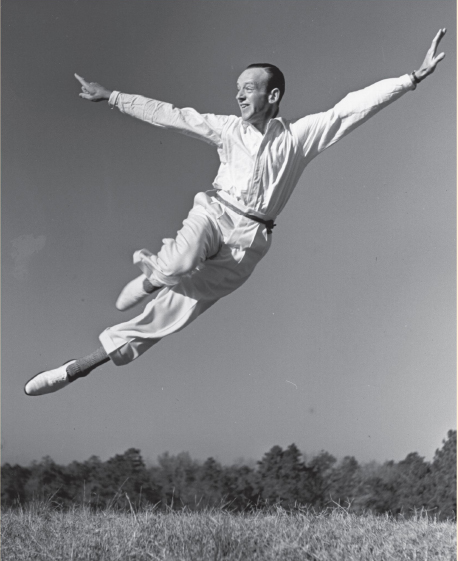
Fred Astaire, whose flashing feet and limber legs not only made him America’s most popular dancer but also set standards for motion picture musical comedies that have rarely been met and never exceeded, died of pneumonia yesterday at Century City Hospital in Los Angeles. He was 88 years old.
Mr. Astaire blithely danced his way into the heart of an America tormented by the Depression and edging toward World War II. His deceptively easy-looking light-footedness, warm smile, top hat, cane, charm and talent helped people to forget the real world that nagged at them outside the movie house.
The Astaire legend, which spanned more than six performing decades on stage, screen and television, began before he was 10 years old when his mother paired him as a dancer with his sister, Adele, the partner with whom he first found success.
Mr. Astaire starred in more than 30 film musicals between 1933 and 1968. Eleven of these co-starred Ginger Rogers, his most durable dancing partner. The music they danced to was written by the cream of the popular-music world, including Cole Porter, Irving Berlin, Jerome Kern and George and Ira Gershwin.
His dance numbers fit neatly within the bounds of a movie screen, but they gave the illusion of being boundless, without regard for the laws of gravity or the limitations of a set.
He was also a paragon among his professional peers. George Balanchine, the artistic director of the New York City Ballet and a man whose supreme standards rarely allowed for superlatives, called him, simply, “the greatest dancer in the world.”
Anna Kisselgoff, dance critic of The New York Times, gave this description of the Astaire genius: “At its most basic, Mr. Astaire’s technique has three elements—tap, ballet and ballroom dancing. The ballet training, by his account, was brief but came at a crucial, early age. He has sometimes been classed as a tap dancer, but he was never the hoofer he has jokingly called himself. Much of the choreographic outline of his dancing with his ladies—be it Miss Rogers or Rita Hayworth—is ballroom. But of course, no ballroom dancer could dance like this.”
SEPTEMBER 24, 1987
BOB FOSSE, DIRECTOR AND CHOREOGRAPHER, DIES
Robert Louis Fosse was born in Chicago on June 23, 1927, the son of a vaudeville entertainer. He began performing on the vaudeville circuit as a child, and by the age of 13 he was a seasoned veteran of many burlesque shows.
After World War II, he formed a dance team with his first wife, Mary-Ann Niles, appearing in nightclubs and stage musicals. In the early 1950’s, he was a dancer and actor in several films, including “Kiss Me Kate” and “My Sister Eileen.” During that period he married his second wife, Joan McCracken.
In 1954, he began a successful run as a Broadway choreographer, winning a Tony Award for his first venture, “The Pajama Game.” He also choreographed the film version of the hit musical. He had a similar success with the Broadway stage and film productions of the musical “Damn Yankees.”
In 1959 he directed his first Broadway musical, “Redhead,” which starred his third wife, dancer Gwen Verdon. He went on to direct such hits as “How to Succeed in Business Without Really Trying,” “Sweet Charity,” “Pippin” and “Chicago,” all of which he choreographed in his characteristically jazzy style.
In his 1978 Tony Award-winning production of “Dancin’,” Mr. Fosse presented a celebration of dance in all its varied forms. Among the performers was Jill Cook, who recalled that she decided to be a dancer after seeing “Sweet Charity.”
After the death in 1980 of the choreographer Gower Champion, Frank Rich of The New York Times wrote that Mr. Fosse “may now be the last active theater choreographer who knows how to assemble an old-fashioned, roof-raising showstopper in which every step bears the unmistakable signature of its creator.”
Joseph Papp, producer of the New York Shakespeare Festival, recalled last night that Mr. Fosse, as a young sailor in the Pacific during World War II, performed in variety shows put together by Mr. Papp.
“I saw at once that he was footjoy, carefree, jaunty,” Mr. Papp said. “He loved to dance. On some islands he would perform in the hot sun for five or six hours. He’d go on until he nearly collapsed from the heat.”
“With the death of Michael Bennett in July, and now Bob Fosse, the musical theater has lost two giants, two great choreographers,” Mr. Papp said.
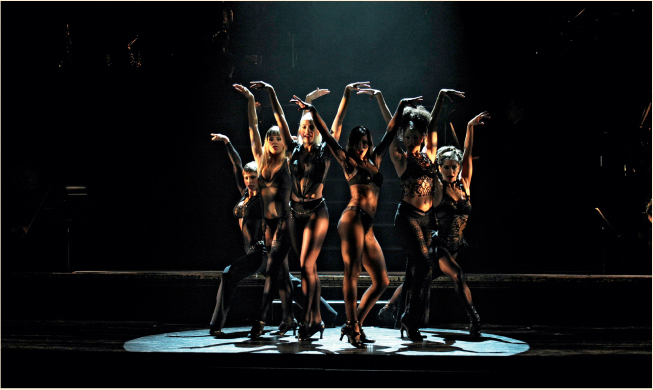
Dancers perform during the rehearsal of Fred Ebb and Bob Fosse’s musical “Chicago.”
New and Mighty Piano Makes Carnegie Debut
Yesterday’s Carnegie Hall concert of the Leningrad Philharmonic, conducted by Aleksandr Dmitriev, was completely traditional. But not so the instrument upon which Lazar Berman played the Liszt Piano Concerto in A. It was a Fazioli F 308 concert grand, a 10-foot-2-inch monster with four pedals, a tripartite lid propped by three sticks and a fighting weight of 1,518 pounds. If nothing else this weight makes it the heavyweight champion of contemporary grand pianos. In recent weeks there has been much word of mouth about this new entry, and even something of a media blitz. In the audience were representatives of major piano companies.
There are only three F 308’s in the world, though a fourth is under construction. The Fazioli is something new in the pianoforte world. The company was formed in Sacile, a city near Venice, in 1981 by Paolo Fazioli, a concert pianist who went into engineering and started researching piano manufacture in the 1970’s.
The F 308 is not cheap. At $77,000 or so it tops the 1,058-pound Bosendorfer Imperial, which sells for around $75,000. The two major American concert grand pianos, Steinway and Baldwin, are priced close to $50,000.
The F 308 sounded impressive in its American debut. It had a clear, singing treble and plenty of power. Its bass may take some getting used to; it is not as firm as the Steinway bass, and it had pronounced overtones. None of this was annoying, and there could be no denying the impact of the instrument. Of course, it will have to be put through the usual tests before any kind of judgment can be made.
After the performance Mr. Berman described it as “a bel canto piano,” as befits the Italian tradition of song. He said that the instrument was still in an experimental stage and that he had not stopped loving his Steinway. Nor will he ever. But he was happy to try out the Fazioli in New York. He said he liked its sonority and power. But he is not happy with the three-part lid. And, as for the four pedals, Mr. Berman was a bit dubious.
“It will take a lot of practicing,” he said. 
NOVEMBER 29, 1987
Unlikely Team Behind an Unlikely Opera
It is a steamy day in Houston, where in a warehouse across the street from the Southern Noodle Company, the director Peter Sellars is running through a scene from “Nixon in China,” John Adam’s opera about Richard Nixon’s 1972 landmark visit to the People’s Republic of China. The scene is Pat Nixon’s tour of a Peking glass factory, and the cast includes the soprano Carolyann Page as Pat Nixon and three contraltos known as the “Maoettes,” a Motown-style back up group comprised of Mao Zedong’s private secretaries, who echo his pronouncements like a Greek chorus.
One of the most trumpeted avant-garde events of the season, “Nixon in China” comes to the Brooklyn Academy of Music’s Next Wave Festival for a two-week run beginning Friday, following it’s inaugural performances last month at the Houston Grand Opera’s new Wortham Center, where it drew sharply divided critical response. Some critics took issues with Mr. Adam’s music, calling it tedious and superficial. Others, however, have called the opera heroic. 

NOVEMBER 20, 1988
CITY BALLET AT 40:
Balanchine’s Legacy Lives
George Balanchine is dead. Any appraisal of the New York City Ballet on its 40th anniversary must begin with this fact and its finality. As the City Ballet prepares to celebrate its first four decades, the question of its future direction becomes as important as its contribution to the past.
The truth—for many, so hard to face—is that five years after Balanchine’s death the City Ballet is no longer Balanchine’s company: Young dancers who never knew the troupe’s founding choreographer have begun to fill the ranks and, although thoroughly schooled in the style of his ballets, they are also affected by the new choreography they dance. While maintaining his repertory and paying allegiance to his moral and stylistic inspiration, Balanchine’s successors are justifiably determined not to look only to the past. The troupe they direct remains the world’s preeminent model of contemporary classicism.
On Tuesday night, the company established by Balanchine and Lincoln Kirstein opens a new season at the New York State Theater by “re-creating” the first program that marked its official beginning. On Oct. 11, 1948, at the City Center of Music and Drama, the young creative troupe presented three Balanchine ballets that will now be seen in the same order: “Concerto Barocco,” “Orpheus” and “Symphony in C.”
No straight line has charted the course of the company’s history. Obviously, the City Ballet of today—Mr. Kirstein is general director, Peter Martins and Jerome Robbins jointly are artistic directors—is not the same troupe that existed 40 years ago or even at Balanchine’s death on April 30, l983. For the first time, the City Ballet seems finally to be emerging from a state of transition, albeit one masked by an esthetic continuity stemming from Balanchine’s especially strong legacy. As the Danish-born Mr. Martins (clearly no New York native) puts it, “It’s as if you’re in the Holland Tunnel with the windows closed and all you want to see is New Jersey. All of a sudden, it’s there. We have gone through what seemed an endless tunnel.”
Certainly, the company has been affected by the fact that one of the greatest choreographers of all time is no longer pouring new ballets into its repertory. At the same time, the Balanchine ballets that still make up City Ballet’s profile continue to define the high standards that ennoble the company. Somewhat unfairly, these same standards imply that Balanchine’s successors will always be compared to him. The company still boasts one of the 20th century’s major choreographers in Mr. Robbins. And while Mr. Martins—the best of the neo-Balanchine choreographers—will probably rank higher in reputation than is now apparent, his contribution lies also in his superior knowledge of classical technique. 
JANUARY 1, 1989
Twyla Tharp: Turning Sharp Corners
“This year is an extraordinary set of circumstances. It’s what I think of as a shakedown,’ says the choreographer Twyla Tharp who, for the first time in 23 years, is without a dance company that bears her name or her singular stamp. This past July, Ms. Tharp announced that she was disbanding the modern-dance troupe she began in 1965 and accepting the invitation of American Ballet Theater’s artistic director Mikhail Baryshnikov to join A.B.T.
Ms. Tharp’s arrangement with Ballet Theater—which has taken on 7 of the 15 members of Twyla Tharp Dance—has led many to wonder how the choreographer will maintain her creative identity and make her mark within a large established ballet company, and whether Ms. Tharp and Mr. Baryshnikov—forceful personalities in their own right—will develop an environment in which both can thrive.
Mr. Baryshnikov believes the presence of Ms. Tharp and her dancers at Ballet Theater will stimulate its classically rooted dancers and extend their stylistic range. He also suspects that the choreographer’s close association with a major classical ballet company will “stretch Twyla’s horizons” and bring both the company and Ms. Tharp new audiences. Several of the choreographer’s earlier works are to be added to the Ballet Theater repertory. 
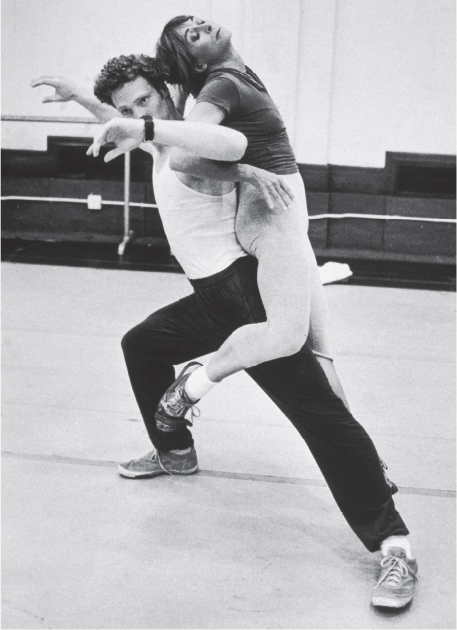
Twyla Tharp rehearses a move, back-to-back with dancer Kevin O’Day.
FEBRUARY 3, 1980
London to Broadway: How a Culture Shapes a Show
At present, four recent London successes are in New York—Harold Pinter’s “Betrayal,” Martin Sherman’s “Bent” (an American play that received its first production in London), Tom Stoppard’s “Night and Day” and the Andrew Lloyd Webber-Tim Rice musical, “Evita.”
In varying degrees, each has suffered—and survived—a sea change. It was enlightening to have seen the plays in both cities. The contrasting productions say something about the incompatibility of British and American attitudes not only toward theater but also toward society and personal relationships.
“Betrayal” is the most recent transfer. Despite Pinter’s position in the top rank of contemporary British playwrights, he has not, until now, had great commercial success of the American stage.
The excellent British actors who originated their roles at the National Theater—Daniel Massey and Penelope Wilton as the married couple, Michael Gambon as the husband’s best friend who is also the wife’s lover—may not have been considered stars of international magnitude. In the United States, the roles are played by Roy Schneider, Blythe Banner and Raul Julia. The director, Peter Hall, and the designer John Bury, and the play are the same. 

JULY 6, 1980
AN ‘EPIC’ DRAMATIZATION OF A DICKENS NOVEL
The Royal Shakespeare Company’s production of Charles Dickens’s “Nicholas Nickleby” is a monumental theatrical experience. Performed in two parts in alternating repertory over a period of eight and one half hours, the play, as adapted by David Edgar, synthesizes the book’s 65 chapters into five densely textured, incident-filled acts. Every major character in the novel is represented on stage—some 150 played by 45 quick-changing actors.
This is as close to a complete “Nicholas Nickleby” as one could imagine within the boundaries of theatrical artifice. A collaborative venture among the actors, the adaptor and the co-directors, Trevor Nunn and John Caird, it is a kind of live “Masterpiece Theater” mini-series—and something more.
Most of the dialogue is direct from Dickens; it is ornate without being fustian. Wisely, Mr. Edgar has also retained a taste of the original descriptive text. In an exemplary use of the Story Theater method, actors issue occasional commentary on their actions and those of others, underscore attitudes and stitch transitions. As chorus, singly and in unison, the company characterizes “this wilderness of London,” where wealth and poverty stand side by side. The play does not shortchange Dickens’s pronounced social conscience, showing, among other things, how the burden of money affects those who need it as well as those have it.
The production is a paradigm of the art of transformation—from actors into a diversity of characters, from theater today into England of the 1830’s, from narrative into drama. The work has an authenticity that surpasses that in any other stage adaptation of Dickens that I have seen. The wretchedness of actual conditions is juxtaposed next to the remembered bliss of “bygone days and childhood times.” Dastardly evil is vanquished by selfless heroism. The latter is, of course, incarnated by the title character.
The production is a paradigm of the art of transformation
Each half of the play is self-sustaining and can be seen separately. The second half begins with a speedy recapitulation of the preceding events. However, for maximum enjoyment the work should be seen in sequence in its entirety. I saw it all in one day, at a matinee and an evening performance, beginning at 2 P.M. and ending at 11:30 P.M., with one hour for dinner. My feeling at the end of the doubleheader was one of satisfaction, not satiety.
As the actors took the last of many curtain calls, it appeared as if they were as reluctant to leave our company as we were to leave theirs. Even though all wrongs were righted and all plot strands were knitted neatly together, one still hoped that there could be more to the story, which is, of course, the reaction we have when we read the book. The R.S.C.’s “Nicholas Nickleby” is a great novel turned into grand theater. 

‘42ND STREET’ LOG—THE MAKING OF A HIT
It was one of the most stunning moments in the history of Broadway theater. Stunning in the literal sense. The opening night audience at the Winter Garden on Aug. 25 had just given 10 rousing curtain calls to the cast of “42nd Street,” the new David Merrick-Gower Champion musical hit, when Mr. Merrick himself entered the stage from the wings. The audience was already on its feet, and Mr. Merrick, who had made a point of keeping out of the public eye during rehearsals and tryouts, received an ovation. “I’m sorry to have to report…’ he said, but was cut off by a roar of applause. “No, no, it’s very tragic,” he continued, this time being interrupted by laughter and applause. “You don’t understand,” he continued almost angrily, “Gower Champion died this morning.” It was an astounding finale. But even had Mr. Champion not died the very day of his opening, the story behind “42nd Street”—from its conception four years ago to its Broadway opening—was destined to become a theater classic.
The idea for the new Broadway musical came to librettist Michael Stewart (“Hello, Dolly!”) some four years ago while he was watching the old movie one night at a West Side revival house. “I was gripped,” he remembers, “by this grandaddy of the backstage stories and how valid it still is.” Mark Bramble, however, with whom he was then developing “Barnum,” felt “reluctant” about the idea until he became enchanted by the Harry Warren-Al Dubin oeuvre (22 movies) filled with sunny tunes like “We’re in the Money” and “Lullaby of Broadway.” Any of these songs, he realized, could be drawn upon to comprise a new musical based on “42nd Street.”
One bright August afternoon in 1978, over lunch at the Plaza, Mr. Stewart and Mr. Bramble showed what they had to David Merrick, whose office boy Mr. Bramble had once been. Mr. Merrick first offered “42nd Street” in the spring of last year to director-choreographer Gower Champion, with whom he had collaborated on seven musicals including one called “Hello, Dolly!,” which ran seven years.
On the last night in Washington, Mr. Champion told Mr. Merrick about his illness. “It was a difficult speech,” recalls the producer, who was willing to discuss this meeting but declined to comment on other aspects of the production. “Gower had no notion he had a short time to live. Nor did his doctor. He just described some blood ailment he had.”
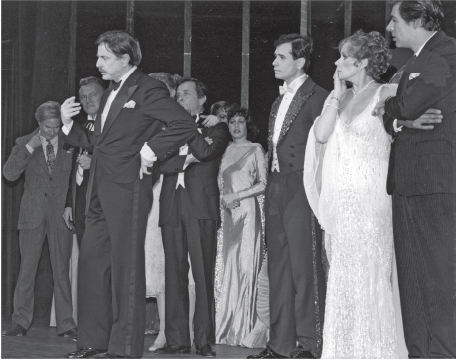
Jerry (right) and the cast of the Broadway musical “42nd Street” looking on as the show’s producer David Merrick (center), at the curtain call, announces that the show’s director, Gower Champion, had died of a rare blood disease some hours earlier.
At his apartment one afternoon with Wanda Richert, an actress in the show, Mr. Champion admitted off-handedly: “You know, this disease could kill me. But if I go, I’m going out in style, I hope.”
The following day, Miss Richert found Mr. Champion at home in a dazed condition and rushed him to the hospital. He died at 1 p.m. on Aug. 25, the day the show was to open. Mr. Merrick was one of the first to be given the news, and he took it upon himself to direct everyone, including hospital authorities, to withhold the announcement until after the opening.
The next morning, all seven of the major New York critics gave the show high praise, especially its musical production numbers. Frank Rich of The Times, who found fault with the book, saluted “Gower Champion’s final display of blazing theatrical fireworks.”
As for Mr. Merrick, his bold gamble created a profit gusher. Since he owns the entire show, his personal income as long as “42nd Street” plays to sold-out houses will exceed $50,000 a week. Subsidiary rights and road companies will generate enormous additional income, but just the Broadway production alone, after a five-year capacity run, would net Mr. Merrick more than $11 million. 
‘DREAMGIRLS,’
Michael Bennet’s New Musical, Opens
When Broadway history is being made, you can feel it. What you feel is a seismic emotional jolt that sends the audience, as one, right out of its wits. While such moments are uncommonly rare these days, I’m here to report that one popped up at the Imperial last night. Broadway history was made at the end of the first act of Michael Bennett’s beautiful and heartbreaking new musical, “Dream-girls.”
“Dreamgirls” is the story of a black singing group that rises from the ghetto to national fame and fortune during the 1960’s. Like the Supremes, to which they bear more than a passing resemblance, the Dreams have their share of obstacles to overcome on the way up. At the end of Act I, the heroines are beginning to make it in Las Vegas, but there’s some nasty business to be dealt with backstage. The act’s hard-driving manager, Curtis (Ben Harney), has come into the Dreams’ dressing room to inform Effie, who is both his lover and the group’s best singer, that she is through.
It’s at this point that Jennifer Holliday, the actress who plays Effie, begs Curtis to let her stay, in a song titled “And I Am Telling You I’m Not Going.” Miss Holliday is a young woman with a broad face and an ample body. Somewhere in that body—or everywhere—is a voice that, like Effie herself, won’t take no for an answer. As Miss Holliday physically tries to restrain her lover from leaving, her heart pours out in a dark and gutsy blues; then, without pause, her voice rises into a strangled cry.
“Dreamgirls” is a musical with almost 40 numbers, and virtually everything, from record-contract negotiations to lovers’ quarrels, is sung.
Perhaps inevitably the cast’s two standouts are those who play characters who do not sell out and who suffer a more redemptive form of anguish: Miss Holliday’s Effie and Cleavant Derricks, as a James Brown-like star whose career collapses as new musical fashions pass him by. Like Miss Holliday, Mr. Derricks is a charismatic singer, who conveys wounding, heartfelt innocence.
Is “Dreamgirls” a great musical? Well, one could quarrel with a few lapses of clarity, some minor sags, the overpat and frantic plot resolutions of Act II. But Mr. Bennett and Miss Holliday have staked their claim to greatness. 
JUNE 22, 1982
LONDON’S ‘CATS,’ A NEW WEBBER MUSICAL
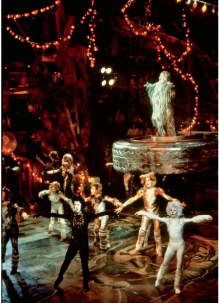
Ensemble scene from the musical “Cats” at the Winter Garden Theatre in New York.
Over the last decade, the young composer Andrew Lloyd Webber conducted a tireless campaign to prove that, yes, the British can create contemporary musicals as sleek and snazzy as Broadway’s. Certainly it can be argued that he has made his case. With two successful shows in New York right now, “Evita” and “Joseph and the Amazing Technicolor Dreamcoat,” and a third, “Cats,” arriving at the Winter Garden next October, Mr. Webber is almost as dominant a force in the American musical theater as he is in England’s.
In “Cats,” Mr. Webber has his best lyricist ever—by the name of T.S. Eliot. The show is a nearly complete musicalization of the whimsical “Old Possum’s Book of Practical Cats,” with an inspirational climax thrown in for last-minute plot’s sake. “Cats” is a true phenomenon here. Even a year into the run, tickets are sold out six weeks in advance, and there are so many “Cats” souvenir hawkers in the lobby of the New London Theater that the whole enterprise resembles a gold rush.
This commercial success could be repeated in New York. The set is a cat’s eye, junk-heap vision of London that, with its three-sided arena configuration, recreates the intimate feel of Mr. Prince’s “Candide” even as it looks like an Anglicized “Hair.” As in those musicals—and “Nickleby”—cast members circulate among the audience, prodding it to purr. Presumably architects will dismantle the cavernous Winter Garden to recreate this crucial ambience for Broadway.
But “Cats” is, at heart, simply a series of feline song-and dance variety turns, and Mr. Webber and Mr. Nunn need a third collaborator, a choreographer, to keep the fur flying as entertainingly as their formula will allow. The British musical theater hasn’t produced any showbiz choreographers at the top American level, and the one who did “Cats,” Gillian Lynne, hasn’t made her dances as distinctive and varied as Eliot’s verses and a full-length dancing show demand.
In New York, Miss Lynne will have some valuable allies: a chorus of Broadway dancers rather than their less proficient and stylish West End counterparts. Her ability to join with them to raise the pizazz quotient of “Cats” may determine whether Andrew Lloyd Webber captures New York’s fancy once more. 
FIERSTEIN AND ‘TORCH SONG’: A DARING CLIMB FROM OBSCURITY
Certainly it is one of the most daring and anomalous plays to ever move to Broadway. A four-hour drama in three parts, Harvey Fierstein’s “Torch Song Trilogy” recounts the story of Arnold Beckoff, a nice Jewish boy of “great wit and want,” who also happens to be an avowed homosexual and a transvestite who makes his living by appearing on stage.

Matthew Broderick (left) starred in Harry Fierstein’s “Torch Song Trilogy” in 1982.
In addition to garnering critical acclaim, the play—which recently moved from an Off Broadway house to the Little Theater—has also brought its author and star sudden recognition. After years of working in obscurity Off Off Broadway, Mr. Fierstein, at the age of 28, finds himself giving interviews at Sardi’s, posing for Richard Avedon and sorting through offers from Hollywood directors. He feels, he says, “like Cinderella.’
“When I started in drag, there were other people doing it,” he explains in a husky whisper, “but only for each other, and I knew I had to make my own place. I knew I had to keep doing it, keep hitting the doors myself and not let them slam in my face. This time, they didn’t slam the door, and it was a shock.”
Only a short time ago, of course, “Torch Song Trilogy” itself would have been cause for shock on the part of some Broadway theatergoers. Although Mr. Fierstein says that he modulates his performance in response to audience reaction—he can let the seduction scene run anywhere from 4 to 10 minutes—the text of the play possesses a willful candor that makes such older plays as “Tea and Sympathy” and “The Boys in the Band” seem cautious and condescending.
Indeed, it is only in recent years that playwrights and authors have been able to deal openly with homosexual themes; in the past, such subjects were couched in metaphors and allusions, and characters who deviated from accepted norms of sexual propriety usually underwent conversion, died or were condemned to lasting unhappiness.
Mr. Fierstein began performing as a transvestite at a Lower East Side club while he was still a teenager. He weighed 270 pounds at the time and specialized in impersonating Ethel Merman.
The drag-club appearances led to a theatrical debut in Andy Warhol’s “Pork” at La Mama in 1971, and by 1973 Mr. Fierstein had turned from acting to playwriting. His first two plays, like “Torch Song,” drew on the homosexual milieu—one of them served as a comment on the Continental Baths, and “Flatbush Tosca” turned the famous diva into a transvestite—but the playwright’s next project, “Spookhouse,” is less parochial in theme.
For the time being, though, Mr. Fierstein is appearing every night on stage as Arnold—an exhausting role that keeps him on stage almost continually during the play’s four hours. “I’m tired, very tired,” he says, “but I wouldn’t trade it for anything. If ‘Torch Song’ were done in the 50’s, it would have played in a little cafe, and that would have been it—an artist can create his own world, but he can’t remake the world. So it’s very gratifying in that a breakthrough has at last been made; there’s at last a real live, out-of-the-closet queer on Broadway. But for me, it doesn’t really matter where I work—as long as I work somewhere.” 